 By Pepper Parr By Pepper Parr
March 3. 2015
BURLINGTON, ON
It is when people can appear before those they have elected and have an open dialogue; an exchange of ideas and concerns that the democratic process works at its best and the way it was supposed to work.
Burlington is not there yet.
Back in 2010 when the Shape Burlington report was published, it was a document put together by former Mayor Walter Mulkewich and the late John Boich. Boich was very close to then Mayor Cam Jackson – he ran his 2010 election campaign.
Jackson created the advisory group to produce a report to take away some of the heat he was getting from disgruntled citizens who were beginning to realize there were real problems with the pier.
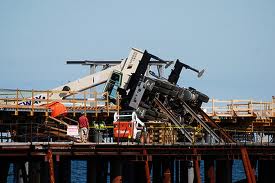 Crane working at the pier site topples. Proves to be the point at which problems with the design became evident. By this time the crane accident had taken place and things were beginning to smell. Law suits were threatened and writs were issued and everyone was off to meet with a judge.
City hall found their collective noses were a little out of joint when the Shape Burlington report was given to Jackson. They felt the report had slammed them, if ever so slightly.
Many people were unhappy with the treatment they were getting from the office of the Clerk.
In the municipal world – the Clerk is a major player. Both the Mayor and the Clerk must together sign each by law that is passed by Council – without the signature of the Clerk – the bylaw isn’t legal.
 City Clerk Angela Morgan; has been with the city for more than 25 years. Doesn’t live in Burlington. Council cannot meet officially without the Clerk being in the room. In closed sessions it is the Clerk who is in place to keep everyone on the straight and narrow. The Gazette has it from more than one source that Burlington’s city Clerk has had to be quite vocal and direct with Council when it is in Closed Session in the past. The Clerk or the chair of the Standing Committee has to read out a statement setting out why a council or a committee is going into a Closed Session and then ensure that the discussion is directly relevant to the reason for going private.
Both city staff and Council members are sworn to secrecy but it is possible to put together a collection of comments to get a sense of how your Council behaves in closed sessions.
In a related article we write about the comments made by the WHO that recently completed an investigation into a complaint from the Burlington Waterfront Committee (BWF) on what did get discussed in a Closed Session on the sale of lake front land between Market and St. Paul Streets south of Lakeshore Road.
BWF people have delegated a number of times on this matter. That group of people is fortunate to have people who delegate very clearly and have their facts well set out. There was an unfortunate occasion when Gary Scobie was delegating on the sale of the Water Street property and Councillor Sharman asked how his Water Street views squared with his views on the Beachway.
Sharman had introduced a totally different subject and put Scobie off his stride. Fortunately for Sharman Scobie was too polite to call Sharman to account for that old political stunt of changing the subject
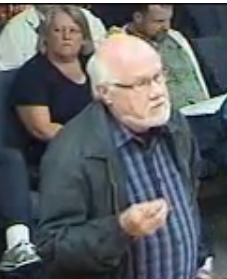 Monte Dennis delegates frequently – ask him what he thinks of this council and the way it responds to delegations. Delegating is an art. The way people delegate in Burlington is set out in the procedural bylaw which most people aren’t even aware of. It is the Clerk’s job to ensure that the bylaw is enforced.
It should also be her job to take steps to ensure that the public is fully aware of the bylaw and take some initiative to ensure the public is educated.
Burlington’s Clerk focuses on enforcement.
Recently a long time Burlington resident wrote us about delegating – how it can be done to be effective
“I have had a delegation or two that was not on the agenda” our source said. “You have to ask or tell the Clerk that you want to speak, and what about. Do this with skill and thoughtfulness.”
Our source had delegated multiple times on a matter that he had put on the agenda. The individual reminded us that ”you were there, and eventually came to my house for a chat about it”.
“I was very insistent about my right to speak”, said the source “although you may have to wait for a meeting date if the next Committee meeting has a full agenda already. The web site directions for delegations allows for this, it’s just more trouble. You just have to push.
 Gary Scobie has delegated frequently; is always well prepared – but can seldom get this council to agree with some of the exceptionally good points he makes “I was told by an ex-mayor that they can’t just stop you, but it’s not straightforward as when you are speaking to an agenda item.
“It also helps to be imaginative about how what you want to say might fit into an existing agenda. For example, the just completed budget process provided an opportunity to position the issue as a budget accountability, business case matter, where the delegate would ask about how this expenditure would fit in.
“The Strategic Planning process might provide another item – the question being how does this property deal fit into the city strategic thinking, and what kind of business case was proposed.
“Imagination and tact, with rational evidence based arguments are needed. It takes time and planning.”
Indeed it does – but it can be done – and when done effectively changes can be made.
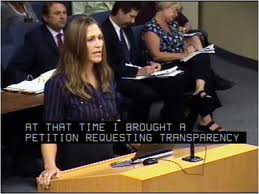 Councillor Marianne Meed Ward used delegations to propel her way into public office. She is one of the few that probes and asks questions of the delegators. It is interesting to note that in Committee of the whole meetings, which are not broadcast, the dialogue between staff and council is very open and very healthy. There is mutual respect most of the time – not always.
That same level of respect isn’t nearly as evident when voters, taxpayers, the people to whom elected officials are accountable to – the same people who consistently say it is an honour and a privilege to serve the public.
Evidence of that honour and privilege is not evident at city hall much of the time.
Our source wrote the Gazette to comment on some of the comments that were appearing.
“I went back and looked at the story again’, he said “and saw that I had commented twice, both suggesting action on the part of the commenters.
“My take in both cases, and similar ones, is that the commenters don’t seem willing to call the mayor or Councillor, or whoever, to account for the issue raised. You have to go to city hall, as a delegation, and demand an explanation. That’s the only way to seek accountability. You have to call them out.”
“The commenters either can’t be bothered, are too lazy, or have no case. Or they like the system the way it is in case they get in power and can act the same unaccountable way.”

 By Mark Gillies By Mark Gillies
March 2, 2015
BURLINGTON, ON
Part oneof a four part feature.
John Waldie was born in Scotland in 1833 to James and Jessie Waldie. The family immigrated to Upper Canada in 1842 when John was nine years old. The family settled in Wellington Square, a village of about 400 residents. Nearby Port Nelson located at the foot of Guelph Line had about 60 residents.
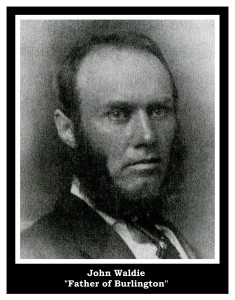 John Waldie was an incredible businessman and philanthropist. He was “The Father of Burlington” & “The Father of the Burlington Library”. James Waldie was a tailor, one of four tailors working in Wellington Square until 1852. In that same year James, Jessie and their young daughter Agnes moved to Huron County and purchased 100 acres of farmland. Their son John, then 19 decided to stay in Wellington Square. Little did John Waldie know in 1852; that one day he would amass a great fortune and his decisions would affect so many people.
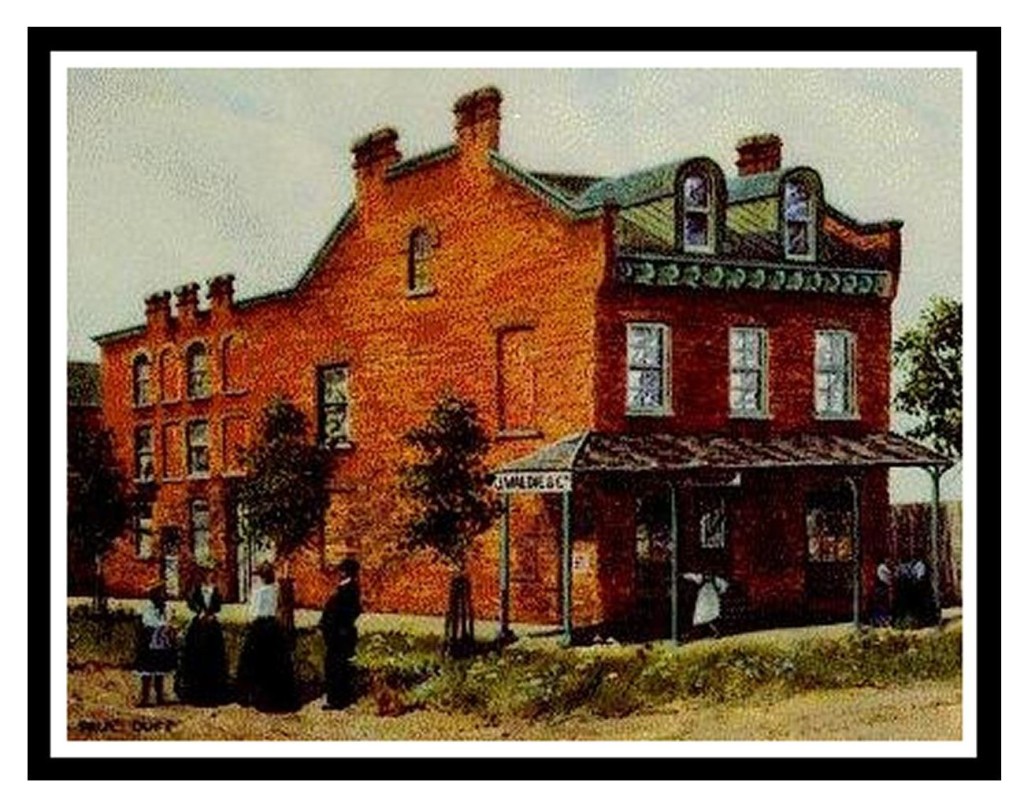 John Waldie’s general store located on the northeast corner of Lakeshore Road and John Street was the place to shop in Burlington for clothing and home furnishings. The store employed 12 clerks, and everyone was kept busy serving a large clientele. John had been employed as a store clerk for one year at the dry goods store of local businessman William Bunton. John was adept at business, and at 22 years of age in 1855, he purchased the business from Mr. Bunton. Not long after, John Waldie built a new store at the northeast corner of Lakeshore Road and John Street. The building is still there, with most of the historic features not visible to most.
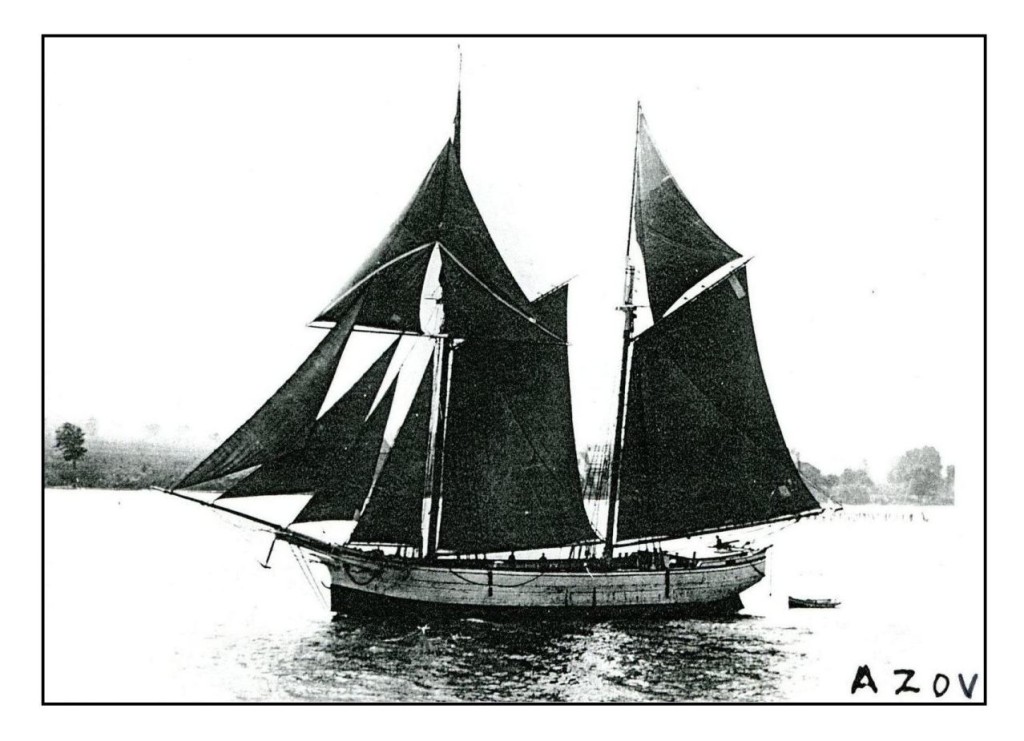 The “Azov” was a freight sailing ship that transported both wheat and timber. The vessel was owned by John Waldie and William Bunton. 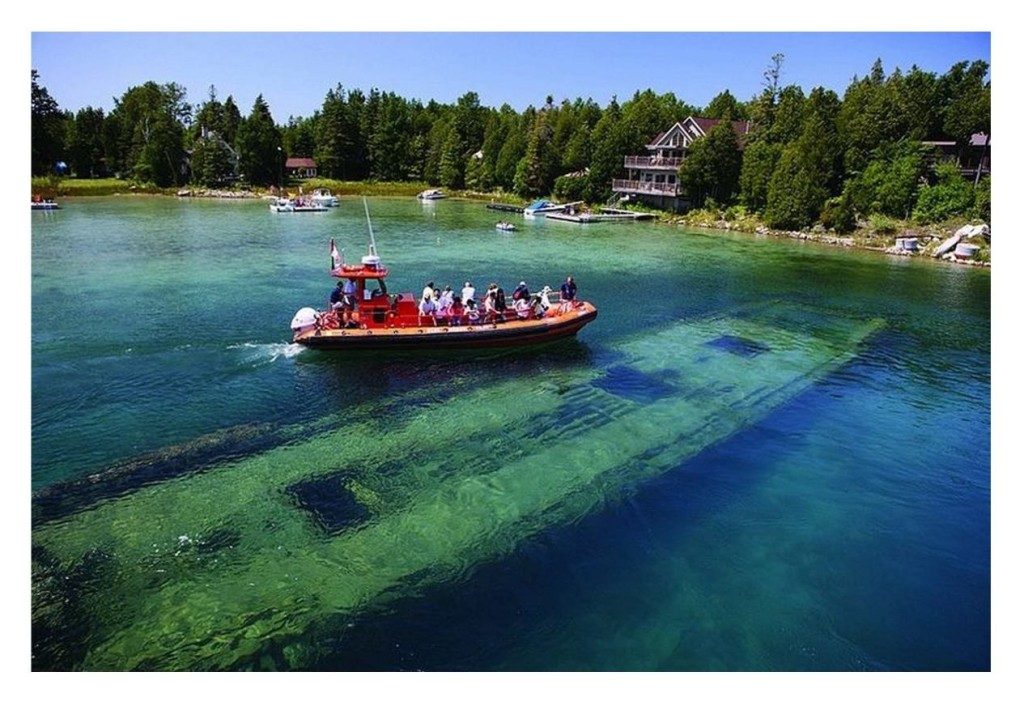 In 1885, John Waldie’s sailing ship “Sweepstakes” sank in Big Tub Harbour at Tobermory. Today, this is Canada’s most famous dive site for ship wrecks. William Bunton and John Waldie continued working together in other business partnerships. Both men entered into the shipping business and owned two sailing vessels. They were called the “Azov” and the “Sweepstakes”. Bunton already owned one of the three wharves located at the foot of Brant Street, and these two ships transported local timber and wheat. The name “Sweepstakes” may be familiar to diving enthusiasts.
The ship was built at Wellington Square in 1867 and sank in Big Tub Harbour at Tobermory around September 3,1885. Today the ship is the most visited dive wreck in Canada.
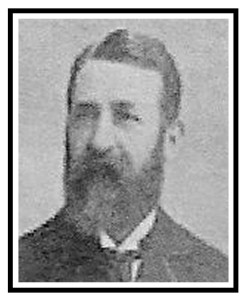 John Waldie and William Kerns were good friends, business partners and political foes. John was a Liberal, and William was a Liberal-Conservative. Both represented Halton County at different times. From 1866 to 1885 John had been in partnership with William Kerns. The store was sold to Kerns when John Waldie moved to Toronto and began the Victoria Harbour Lumber Company. In 1887 Waldie decided to enter federal politics as a Liberal candidate, and represent Halton County. The riding was held by William McCraney, a Liberal, and a wealthy lumber merchant, who won the seat in 1882 when Sir William McDougall, a Father of Confederation, decided to run in another riding. When McCraney decided not to run for a second term, his friend John Waldie decided to run for office in the 1887 election.
Waldie’s Conservative opponent was local merchant David Henderson. The vote was close, Waldie 2,222 votes; Henderson 2,213 votes. Up to this election, John Waldie had been very active in the local community.
For two years, John had been the Reeve of Nelson Township and was elected to become the first Reeve of the Village of Burlington in 1873
Burlington was the name selected to replace the names Wellington Square and Port Nelson.
It was John Waldie who was the “architect” for combining the two communities together. In 1877, it was reported, “Whether for good or evil, the fact of incorporation is due to Mr. Waldie”. I think it is quite fair to say, John Waldie is the “Father of Burlington”. In 1877 John Waldie then moved on politically and became the Warden of Halton County for two years, a forerunner of today’s Regional Chairman.
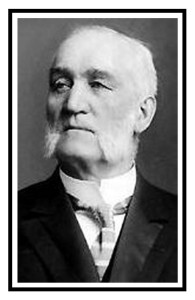 David Henderson and John Waldie had a mutual respect for each other. Both men battled for the same federal riding of Halton County several times. John Waldie represented Halton County federally several times. His 1887 win was short lived, lasting only one year. Amidst allegations of bribery, a by-election was called, and David Henderson, a Conservative in 1888 won Halton County. John Waldie did not contest the seat. But Henderson also faced similar allegations of corruption, and another by-election was held, just six months into office.
This time Waldie and Henderson faced off for a second time. The election was close. Waldie 2,042 votes; Henderson 2,018 votes. The next election was in 1891, and the two were at it again. The vote was close, Henderson 2,441 votes; Waldie, 2,337 votes. Another by-election was called in 1892 and David Henderson was acclaimed. In the 1896 election, the two men squared off for the last time. The election was close, Henderson 2,460 votes; Waldie 2,376 votes.
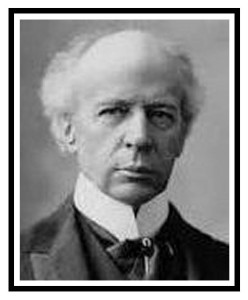 John Waldie while serving in Ottawa as the Liberal representative from Halton County, developed a close friendship with Prime Minister Sir Wilfred Laurier. This friendship helped Waldie after he left office. John Waldie was also President of the powerful Lumbermen’s Association, and he lobbied on behalf of the lumber industry, fighting against unfair trading practices by the Americans. John Waldie’s political career had come to its conclusion. While in Ottawa, he did manage to make some great connections. One of his closest friends was Sir Wilfred Laurier.
John Waldie and his family moved from Burlington to Toronto in 1885, however they still regarded Burlington as home. It’s not that they wanted to move away; they had to move in order to properly develop his new Victoria Harbour Lumber Company.
 Historic Knox Presbyterian Church on Elizabeth Street was the recipient of custom made imported stained glass windows; a gift from philanthropist, John Waldie. John Waldie was a Presbyterian, and a member of historic Knox Presbyterian Church on Elizabeth Street. When you drive by the church, have a look at the beautiful stained glass windows. John Waldie had them manufactured in Scotland and brought them over as a gift for Knox Presbyterian Church.
John Waldie believed in reading as the best means to develop your learning capacity. In the very early 1900s, the Village of Burlington was having difficulty with establishing any kind of a library system. At the time, various residents would keep a small selection of books in their own homes, and area residents would drop by and borrow one or two books. The system was not working and in danger of closing. On hearing of this situation, John Waldie proposed a solution.
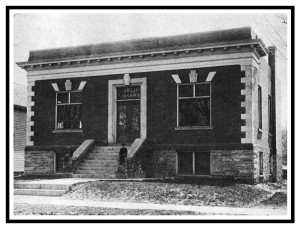 The new Burlington Public Library opened its doors in 1906. The building and books were donated by philanthropist, John Waldie. The Public Library was located on Brant Street, where the City Hall is today. If the Village of Burlington could find some land, Waldie would build the library building, and donate it to the village. When the new facility opened in 1906, Mr. Waldie also stocked it with a donation of 6,000 books. I think it would also be accurate to call John Waldie, “The Father of the Burlington Library”.
By a deed dated 30 September 1888, The Greenwood Cemetery Company of Burlington purchased eight acres for $2,000. The Greenwood Cemetery Company was owned by John Waldie and they purchased the land from local market gardener James C. Filman for the purpose of establishing a cemetery. Block 50, a large block near the centre of the cemetery was purchased by John Waldie on 2 December 1889. Waldie’s parents, both Presbyterians, died in 1864 and 1868 and were buried in St. Luke’s Anglican Cemetery. Knox Presbyterian Church did not have a cemetery. These two burials motivated John Waldie into creating the Greenwood Cemetery Company.
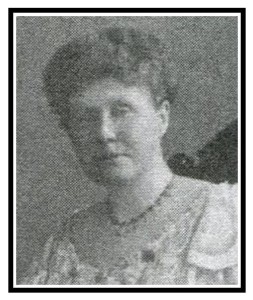 Sarah Ann Jarvis was just 29 years old when she married the widower John Waldie, who was 52 years of age. Sarah was to become a stepmother, since John was the father of 13 motherless children. On September 18, 1885, John Waldie, a widower married for a second time. The new bride was Sarah Ann Jarvis, who at 29 years of age was 23 years younger than John. Waldie’s wedding gift to his new wife, Sarah was a home located at 3265 Mayfair Place in Burlington.
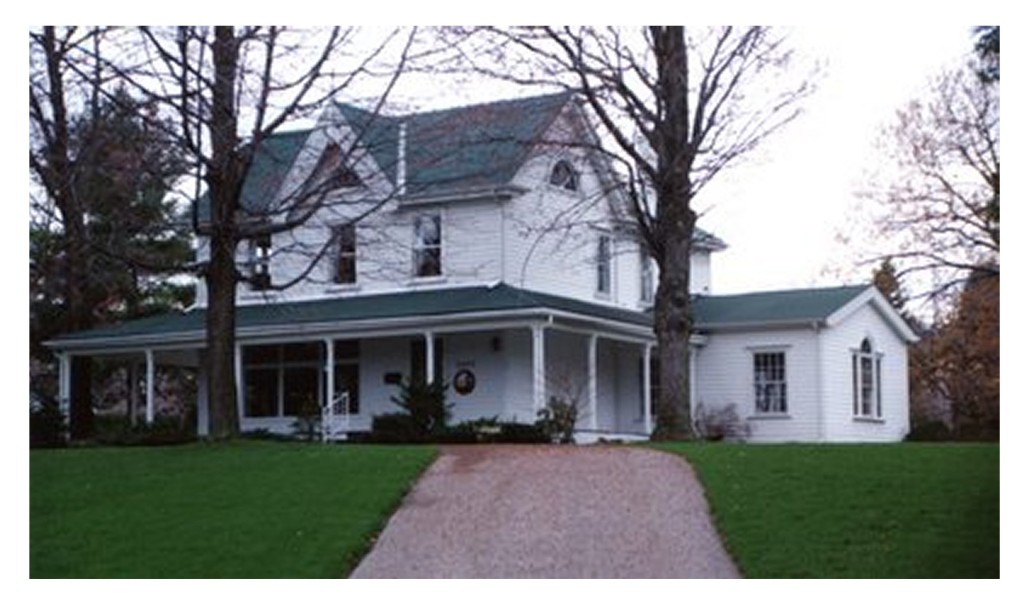 John Waldie purchased 3265 Mayfair Place as a wedding present in 1885 for his new bride Sarah Ann Jarvis. The residence was called “Erin” and the home still retains this name today. It was called “Erin”. Originally built in 1845 by Henry Sovereign, a United Empire Loyalist descendent, owned later by Moses Wilkins, then owned by John Waldie, this historic home has undergone several cosmetic alterations. The residence is located behind the Water Treatment plant on Lakeshore Road, but at one time the home sitting on a small hilltop commanded a beautiful view of Lake Ontario. The Henry Sovereign residence “Erin” is very similar to “Sovereign House” in Bronte; another historic home that was built in stages by fellow relative Charles Sovereign between 1825 and 1846. Today, the home is operated by the Bronte Historical Society and is used as a museum.
John Waldie died at 3:00 PM, June 12, 1907 at his residence “Glenhurst” located in the prestigious Rosedale area of Toronto. A week prior to his death Waldie suffered from bouts of violent coughing. Waldie, already in ill health, had a weakened heart and was unable to survive.
The funeral procession for John Waldie originated in Toronto. The Grand Trunk Railway with a special funeral train transported the mourners and coffin from Toronto to Burlington’s historic Freeman Train Station. The coffin was removed and transferred to a hearse provided by the Edgar Williamson Funeral Home on Brant Street.
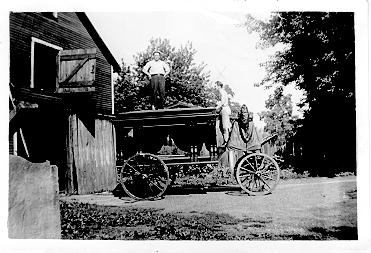 Edgar Williamson operated the local funeral home in Burlington. Today, we know it as Smith’s Funeral Homes. Mr. Williamson provided the horse-drawn hearse to carry the late Mr. Waldie from the Freeman Train Station to his final resting place in Greenwood Cemetery. The procession slowly made its way to Greenwood Cemetery traveling south on Brant Street, and turning right on to Water Street. Brant Street was lined with mourners as they paid their final respects to a favourite son. It wasn’t a state funeral, but it was visually overwhelming. At Mr. Waldie’s funeral, one of the many in attendance to pay respects to this great man was David Henderson, John Waldie’s political adversary. John Waldie, a self-made man, had returned home to his beloved Burlington for the last time.
My next article will be about John Waldie’s Victoria Harbour Lumber Company. This company made John Waldie one of Canada’s wealthiest men, and the second most powerful lumber baron in Canada.
Mark Gillies is a lifelong resident of Burlington, who grew up in Aldershot and developed as a local historian, researcher, master genealogist and writer who has a passionate interest and extensive knowledge of the many early pioneer families.
Mark will write a regular column about colourful local history introducing Burlingtonians to the people that made this city what it is today.

 By Pepper Parr By Pepper Parr
February 27, 2015
BURLINGTON, ON
City hall has announced the closing date for nominations for a BEST AWARD. It is April 7, 2015
There are a number of categories – all have merit.
What the awards don’t have is an acceptable level of transparency which tarnishes what is an important program that recognizes individual effort to better the community.
Last year there were a number of nominees whose names were put forward by either their spouses, partners or parents.
This is what fan clubs do.
 An award given by a community with the nomination coming from people who have taken the time to think about who they want to recommend is a true award. When Mom fills in the form and sends it in – it just isn’t quite the same. An award given by a community with the nomination coming from people who have taken the time to think about who they want to recommend is a true award. When Mom fills in the form and sends it in – it just isn’t quite the same.
The prestige behind the award is paramount to its usefulness. To be a true award with value there can and perhaps should be years when an award is not given.
This city keeps telling anyone with two ears that we are “the best mid-sized city in Canada” There is an opportunity with the Burlington Best awards to begin to behave like one.
There have been comments in the past about people who have “’gamed” the nomination and used the award to start a political career.
In 2011 a small group of people had gathered in the foyer space outside the Council chamber at city hall to talk about John Boich’s health. It was not good and he died several weeks later.
One of the group said to the others” I want to nominate John for an award – the rest of the group immediately agreed and collectively they put together the documents.
John was named the Citizen of the Year several hours before he died in 2011.
The terms of reference for the Awards committee appear to have a sunset date of 2006 – they need an update.
The following are the awards given by the city.
• ARTS PERSON of the Year: An individual who has contributed to the arts in Burlington as an artist, patron or advocate including but not limited to, visual arts, media arts, musical arts, performing arts and literary arts.
• Citizen of the year: A person whose volunteer activity has made a significant and sustained contribution to the vibrancy and wellbeing of the Burlington community.
• Junior Citizen of the year: A high school student, 18 years or younger who has made a significant contribution to the Burlington community.
• Senior Citizen of the year: A person, 55 years or older who has advocated on behalf of seniors and/or made a significant contribution to the Burlington community.
• Environmental Award: An individual or group that improved and/or protects Burlington’s environment.
• Community Service Award: An individual or group whose volunteer activity has contributed to the betterment of the Burlington community.
• Heritage Award: An individual who has demonstrated a commitment to the preservation of Burlington’s heritage, and has volunteered their time in an effort to support the preservation of Burlington’s heritage.
There are people who have done some incredible service for both the city and its citizens. Forms and background on the procedures can be found HERE

 By Ray Rivers By Ray Rivers
February 19, 2015
BURLINGTON, ON
Did a Tim Hortons staff member really pour cold water on a couple of homeless folks sleeping outside a Vancouver donut store recently? The fast food chain has had its share of misadventures over the years, but this is disgusting. On the other hand, given where this Canadian icon is heading, it all may be prophetic.
Timmy is Canada’s largest fast food retailer, leaving McDonalds in its dust and Starbucks at the starting gate. And Burger King is just a Tim bit, though it has just swallowed up Tim Hortons, donut hole and all. This is only the second marriage for our Canadian success story, the first one, also to a US burger chain (Wendy), ended in divorce.
But last December, industry minister James Moore, believing success is not enough, allowed Tim Hortons to be eaten up by Burger King’s Brazilian owners, 3G Capital. 3G is one of those funny-numbered buy-out companies – one with a reputation for taking over prosperous companies, cleaning house and running the business into the ground.
 Are staff pouring water and coffee? A bizarre stipulation in the takeover agreement allows the new owners to fire up to 20% of the corporate staff. And sure enough, 350 employees were out the door before the ink had even dried on the papers. An independent analysis estimates that as many as 700 jobs will likely have to be cut, some 44% of the total administrative staff, before the knife can be pulled out of the victim. And it is estimated that this buy-out will also reduce federal tax revenues by as much as $700 million dollars a year.
Another win-win for the economy? Isn’t this just so deja vu? Stelco, another Canadian icon was given license to be rolled-over by US Steel in 2007, with a host of conditions which the new company simply ignored, despite threats of legal action by the government. Two years later the US parent had started wrapping up Canadian operations and today our premier Canadian steel company has gone into receivership. Domestic production has been replaced by imports, the jobs have vaporized and the provincial government is going to have to bail out the pension plan.
 If you wanted to – you could buy the kitchen sink as well. And then there is Target which bought out the Zellers retail discount store chain (133 stores) only a couple of years ago. The former employees were all fired, the union kicked out and new staff hired to replace them. Then a few months ago, Target announced that it had decided to close all of its Canadian operations and lay off all 17,000 front-line workers, without any severance pay.
But there are some severance payments being made to the corporate staff, though the entire severance package for Target Canada is smaller than the $70 million being paid to Target’s outgoing CEO. After all, he is the man who presided over this cluster-cuss that has led to the closings.
As an aside – US CEOs thirty years ago used to make 46 times the income of their average employee. Today that income gap has grown to 350 times. Canada, being a little behind our American cousins, is only at 200, though that is still one of the largest income gaps in the developed world (UK is 84). Target paid their main man 597 times the pay of the average Target worker. But he didn’t beat his peer at Walmart, whose total annual income package is over a thousand times the average Walmart employee’s salary.
No question about it – Investment Canada has been sleeping at the switch – assuming there actually is a switch and somebody at that agency knows how to work it. We all understand that foreign investment is essential for economic growth in an economy, but allowing predatory buy-out practices of Canadian enterprises, only to drive them into the ground, is not sustainable.
Besides, not all investment needs to be about corporate giants gobbling up our homegrown enterprises. And since competition is a keystone of our business economy, shouldn’t we shun investments which merely increase concentration and reduce competition? And why aren’t we encouraging foreign investment where it is badly needed in new projects, like Ontario’s ‘ring of fire’?
The truth is that Stephen Harper’s record of managing foreign investment is miserable. But there is blood on the hands of all the governments since Mr. Mulroney first scrapped the Foreign Investment Review Agency. Today sadly, there is no coherent foreign investment policy in this country.
A couple of years ago, while the government was snoozing, we almost lost control of our potash industry. Fortunately the premier of Saskatchewan stepped in to save the day. And it was only after the penny dropped – that we were losing control of our oil sands to China – that our PM was forced to hobble together a knee-jerk response.
The reality is that globalization is dead. 9-1-1 was like a bucket of water dousing a campfire, the last smouldering embers of unimpeded free trade squelched by the sanctions on Iran, North Korea and Russia. In fact, the potential nightmare of an untethered global investment policy came to a screeching halt over a decade ago, as the world’s nations firmly rejected something called a Multilateral Agreement on investment (MAI).
The MAI was a naive initiative by the worlds largest transnational corporations trying to wrestle control of the business sector out of the hands of governments – as if borders ceased to exist when it came to investment. Nevertheless, unassailable corporate rights have been embedded in the so-called free-trade agreements which Canada has been only too eager to sign unto, such as NAFTA and the Canada-EU deal.
 In fact, Germany has stated that it will not ratify the draft Canada-EU trade deal unless sections granting the rights of companies to sue governments are removed. Ms. Merkel understands the danger to her ability to govern her people in the face of a trade agreement which allows companies to ignore environmental and other regulations – or to sue the government. In fact, Germany has stated that it will not ratify the draft Canada-EU trade deal unless sections granting the rights of companies to sue governments are removed. Ms. Merkel understands the danger to her ability to govern her people in the face of a trade agreement which allows companies to ignore environmental and other regulations – or to sue the government.
Canada needs a foreign investment policy which serves Canada’s interests. This aspect of managing our economy is too important to be hi-jacked by the ideologically-driven among us. Why would we ever allow a foreign takeover which explicitly sets out to kill jobs, as the Tim Hortons buy-out does? Why would we approve take-overs which serve to increase corporate concentration and reduce competition and efficiency in Canada’s economy?
And why should we allow our homegrown success stories to get usurped by extra-national companies just out to make a quick buck? Call it saving free market competition or call it economic nationalism, it sure beats pouring cold water on our entrepreneurs.
 Ray Rivers writes weekly on both federal and provincial politics, applying his more than 25 years as a federal bureaucrat to his thinking. Rivers was a candidate for provincial office in Burlington where he ran as a Liberal against Cam Jackson in 1995, the year Mike Harris and the Common Sense Revolution swept the province. Ray Rivers writes weekly on both federal and provincial politics, applying his more than 25 years as a federal bureaucrat to his thinking. Rivers was a candidate for provincial office in Burlington where he ran as a Liberal against Cam Jackson in 1995, the year Mike Harris and the Common Sense Revolution swept the province.
Links to background information:
B.C. Homeless Tim Hortons Burger King Timmy’s Takeover
Tim Hortons Layoffs Tim’s Losses Stelco Stelco Closing
Stelco Pensions Zellers
Target Target Takeover
Target Closings Target Severance More Target Severance Investment Canada
Globalization The End of Globalization MAI Germans on Free Trade Deal Investor Rights

 By Pepper Parr By Pepper Parr
February 13, 2015
BURLINGTON, ON
For Ward 5 Councillor Paul Sharman, it is all about the data. Without data – he doesn’t want to make a decision. The decisions he makes with the data tend to have an ideological tinge to them.
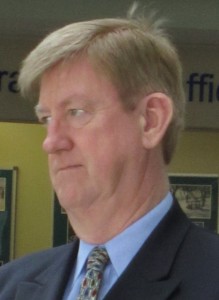 Ward 5 Councillor Paul Sharman is said to have his eye on the provincial seat. About a week ago a Gazette reader sent us a copy of a letter Sharman had sent out. We made a few phone calls to reliable sources and learned that a number of people got the same letter – so we did a short piece about Sharman’s apparent interest in running for higher office.
Talk about data: the comments made on the piece were numerous – which was interesting. What caught our attention was the number of people who read the story. It led the list of readers on one day and was in the top three for four days.
What gives? We’ve no idea – all we can say is that the story was read by a lot of people. A look at the comments section will give you some sense as to how some people reacted to the news.
Premier Kathleen Wynne hasn’t been in office a full year yet – and assuming she behaves, which is questionable given what we’ve seen recently – the province will not be going to the polls until 2018 – which happens to be when Burlington will go to the polls as well.
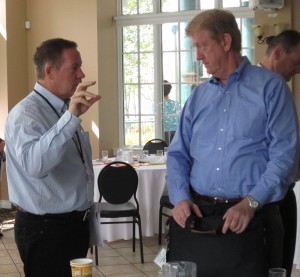 Paul Sharman, on the right, is not an easy man to convince. Here he leaves the distinct impression he isn’t buying what former Mayor’s office Chief of Staff Frank McKeown is selling., So if Sharman is casting a covetous eye on the provincial seat the dates do align for him. The province would go to the polls in the Spring or Summer of 2018 – which would give Sharman enough time to do it all over again should he not succeed in beating Eleanor McMahon, the current member for Burlington.
Assuming a 2018 election for the province is not something I would bet on.
The Premier has two nasty pieces of business on her plate: the scrubbing of data from hard drives once she was in office and the conversation the Ontario Provincial Police want to have with her over the suspicion that a job was offered to a Andrew Oliver, a possible Sudbury candidate that the Liberals wanted to step aside so their choice could run for the seat in the Legislature.
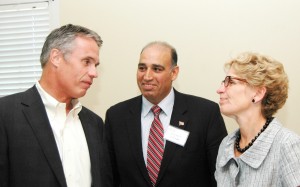 Mayor Goldring chats with then Minister of Transportation Kathleen Wynne. He wasn’t buying what she was selling then. Will the provincial police buy the story she gives them over the Sudbury scandal? Karmel Sakran, the Liberal candidate in the last McGuinty election looks on. The scrubbing of the hard drives is related to the decision to cancel the construction of gas plants in Ontario before the last provincial election. That decision was said to have cost the province millions – but they did win the election.
The squabble over who would be the candidate in Sudbury and the claim that a reward was offered to Olivier if he did not run is now the subject of a police investigation.
The candidate the Liberals wanted ran and won the Sudbury seat.
Olivier has chosen not to go quietly into the night. He recorded a conversation he had with one Pat Sorbara in which is seemed clear to me that something was being offered. The tape runs for 24 minutes – it isn’t pretty.
The police will decide if a criminal act took place and do what they have to do. Liberals in this province are looking at a situation where their Premier is being invited in for a conversation with the police who are conducting a criminal investigation. THAT is astounding – the only thing keeping a bit of a lid on all this is that the Progressive Conservatives don’t have a leader – they are going through a leadership campaign. They will choose a new leader May 9th. In the world of politics that is years away. Kathleen Wynne has two months to clean that mess up.
The Conservatives must be pulling their hair out – a great political scandal – and it looks like it is going to get away on them. I can just imagine the indignant howls that Tim Hudak would be making in the legislature.
The Liberals have always had great “operatives” – this will get buried unless there are real tough, tough cookies at the OPP – and given that the Premier chooses the person who heads up that police service. Well – you figure it out. It does smell.
Sharman’s letter to local Progressive Conservatives.

 By Pepper Parr By Pepper Parr
February 7, 2015
BURLINGTON, ON
Response to our readership survey is doing well.
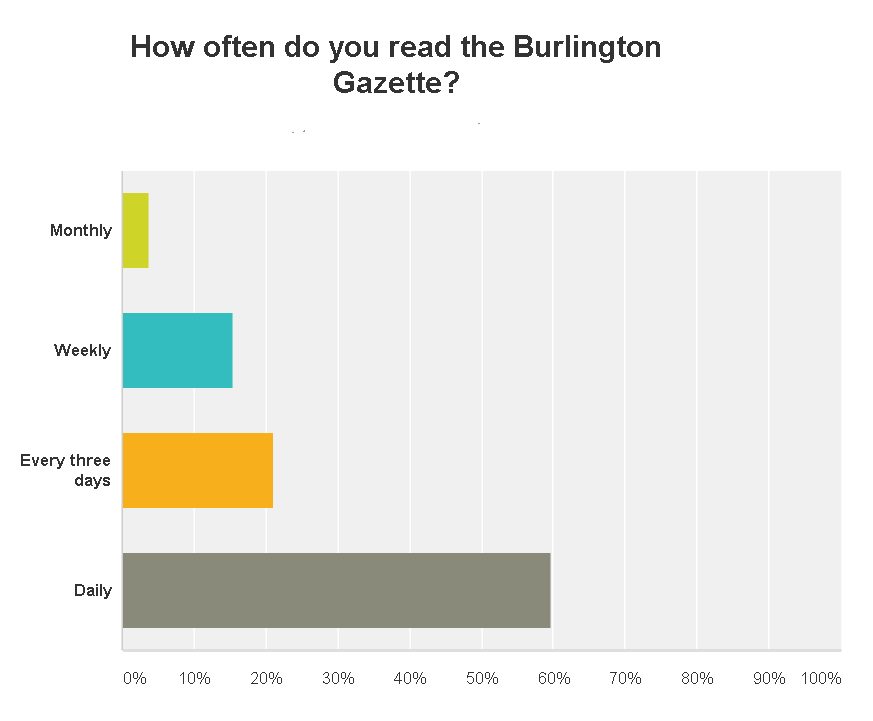 We’d like to convert those weekly and every three day people to daily readers. The monthly readers were all residents somewhere other than Canada. Snowbirds maybe? We asked our readers what they think of the work we do and what they would like to see more of and what they would like to see less of. The survey will stay up for 21 days – and then we will publish the results.
One thread that is consistent is the reaction to opinion pieces that are clearly political. We have two people who write a “column”. We don’t tell the columnist what to write; each one comes up with ideas of their own and they run them by the publisher. I get to say Yes or No.
Columnists are people with opinions, insight and experience. They are a critical part of a civilized dialogue that needs to take place in every community. The work done by a “columnist” is not reporting nor is it journalism. It is comment and opinion.
On a number of occasions we have run pieces offered to us by people running for office. We think it important that anyone running for office be given an opportunity to get their ideas out to the public. We were not interested in their ‘platform’ but we were interested in their thinking process. There were more than a dozen that were offered to us during the last election that we turned down – not because of the candidate but for what they had written. Most just gave us their platform – that’s advertising. We were interested in think pieces.
We also interview candidates and elected officials. During the last election two candidates refused to be interviewed.
A number of people made comments on these political viewpoints. We have reproduced several below and have added our own commits to the views these readers have expressed. We’ve not used the names of the writers but have put in initials to separate the views of one writer from those of another.
JF: “I agree that the coverage of City Hall is the strength of the Gazette. It fills a void. It does it well.
I get annoyed when they write upon or “create” Federal “issues” with the well-known Liberal Propaganda slant. It is not helpful. It simply comes across as a blowhard bravado and the motives are obvious. The Liberal Party echo chamber loves it, but it is of little value to the community. Zero value to journalism.”
This writer seems to not appreciate that the writer is a columnist – sharing an idea or a concept or a criticism. Yes, Ray Rivers is a known Liberal and writes from that vantage. Mike Wallace is Burlington’s MP – when he distributes his newsletter door to door you know that he is going to tout the Conservative party line – that what he is – a Conservative.
“When we can discuss and debate issues with a non-partisan perspective, value is added. When the so-called “debate” is simply to retort to the Liberal Party position on something Ray or Pepper have concocted, it is just that. A retort.”
We don`t for a second think a partisan comment does not add to the debate. The Conservatives fought hard to create the CBC; the Liberals fought hard to end capital punishment. Were these `partisan` issues?
“I know what to expect if I buy Torstar papers vs the National Post. I know what to expect if I watch CBC rather than Sun News. Is this what we want the Gazette to evolve into?”
Burlington does seem to have a problem with independent opinion. Ray Rivers is a Liberal, always has been. Thinks marijuana should be legal -the publisher disagrees with him and that the Senate should be abolished – again the publisher disagrees with Rivers.
I hope that as publisher of the Gazette we offer our opinions and make certain that there is space for people with other opinions. There are a couple of genuine nut cases out there that we don’t publish.
DG:
“Completed the survey, but disappointed that I didn’t get the opportunity to comment on the op ed-style pieces written by Ray Rivers and various candidates, including the Liberal candidate for the provincial riding. Very politically biased writing. Certainly not balanced reporting or opinions. The Gazette is more of a Liberal mouthpiece than The Star.”
DD: “The blatant Liberal propaganda and negative representation of other parties is a little bias for my taste but it is your Gazette (I did agree with Ray just recently………..so perhaps the blog is working).”
We were asked why there was not a regular column from a Conservative. Russ Campbell produced a few for us – but he decided he would rather publish his own material. We have approached a few “died in the wool” Conservatives – no takers yet.
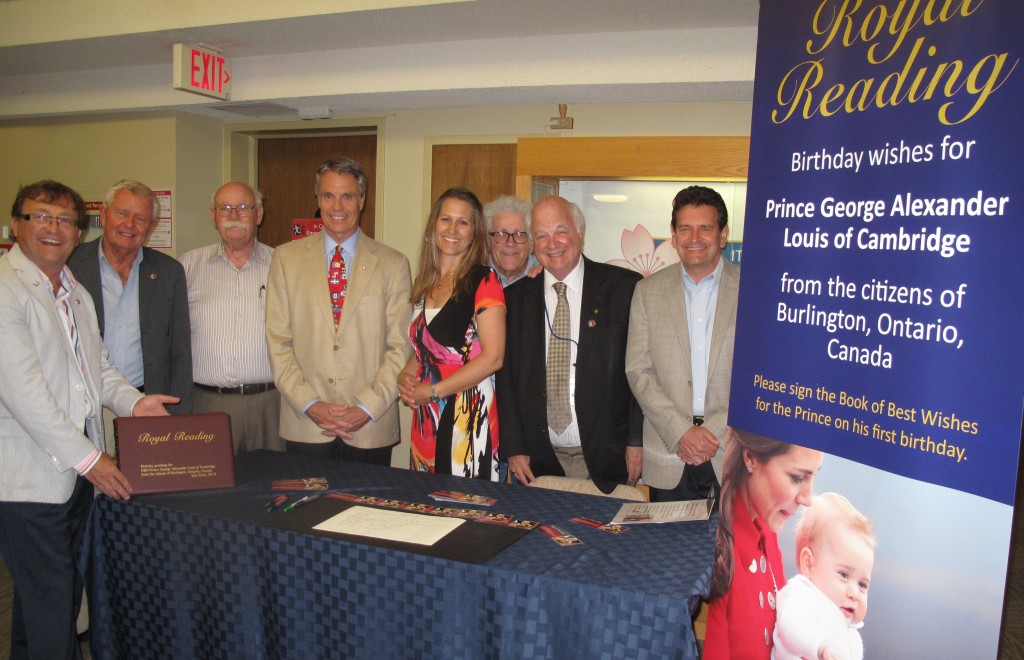 From the left: MP Mike Wallace proudly displaying the Book of Best Wishes that went to the Prince as a first birthday card, Councillor Jack Dennison, Joe Veitch, without whom the Book of Best Wishes would never have been done; Mayor Rick Goldring who was an early supporter of the project, Councillor Marianne Meed Ward, originator of the Book of Best Wishes idea and publisher of the Gazette, Councillors John Taylor and Rick Craven. What we don’t want is material sent to us by either the MP or the MPP that someone in Ottawa or Queens Park wrote for them. We are interested in publishing viewpoints that stir debate and bring forward fresh ideas that can be defended.
We get material from the provincial government daily. The local MP seems to have forgotten our address – but when there was a photo opportunity – he was front and centre – actually on the left in this photograph.

 By Ray Rivers By Ray Rivers
February 4, 2015
BURLINGTON, ON
I never cared for John Baird. I remember sitting in the public gallery at Queen’s Park watching with disgust as he single-handedly created disorder, yelling at the Liberal government from his opposition bench like a spoiled three year old. He was one of those over-zealous immature partisans who liked to hear himself yell, mistaking noise for progress. Even with age and the experience of senior governance, I believe that little spoiled boy is still in there. People like that just don’t change.
 His first Cabinet role was as a pit bull in the Harris government, oppressing the poorest and most vulnerable Ontario residents during the mid 1990’s recession. As Minister of Community and Social Services, he was the ruthless Tzar of Harris’ reactionary WorkFair program. His first Cabinet role was as a pit bull in the Harris government, oppressing the poorest and most vulnerable Ontario residents during the mid 1990’s recession. As Minister of Community and Social Services, he was the ruthless Tzar of Harris’ reactionary WorkFair program.
As Minister of Energy in the Eves government, he totally mismanage the energy file. He was responsible for Hydro One (remember Eleanor Clitheroe). The file was so badly bumbled that the Eves government had to subsidize and re-regulate electricity rates, which had sky-rocketed to record levels and had been accompanied by rolling power blackouts. And then there was that huge province-wide blackout in the summer of 2003.
I always found it strange to see Baird welcomed into Harper’s Cabinet. After all there were so many homophobic Tories engaged in a rear-guard action to ban same-sex marriage, which the Liberals had made law. It is to Baird’s credit he managed to turn the PM and the rest of the party around on that issue. And it took courage, as he has shown on occasion to vote against most of his party on this issue.
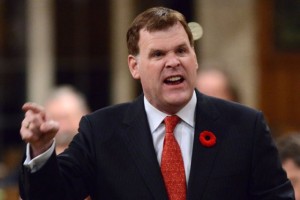 Baird’s legacy is a wasteland of de-funded and disempowered agencies and non-profit organizations. His first responsibility in Harper’s Cabinet was introducing the much heralded ‘Accountability Act’, only years later to watch the Tories become the most secretive government in modern history. Despite his passion for human rights, Baird’s legacy is a wasteland of de-funded and disempowered agencies and non-profit organizations, which had ostensibly been pursuing that very objective.
He was an embarrassment as federal Minister of the Environment. Canada’s environmental agency put an end to undertaking much research and scientific knowledge, climate change in particular. Hear no evil, see no evil – ignorance is bliss. Columnist Andrew Coyne summed up Baird’s job in the environment portfolio, referring to the new Minister as “the man sent to kill the issue”.
Baird was the trigger-man who ended Canada’s commitment to climate change by taking us out of the Kyoto Protocol. Not only was Canada no longer interested in trying to reduce greenhouse emissions, it was opposed to developing serious alternatives to Kyoto. Government policy now included obstruction and subversion of any collective international action on climate change (Bali and Cancun climate change conferences).
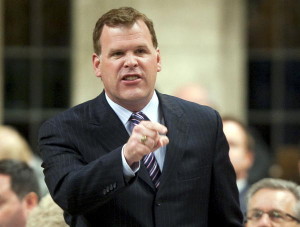 Under Baird Canada’s foreign policy underwent a more partisan self-serving transformation. Perhaps that is what qualified him in Mr. Harper’s mind, to be promoted to Minister of Foreign Affairs. And he didn’t disappoint. One of his first actions was to close the Iranian embassy, to the puzzlement of just about everyone. Baird has been praised for his strong protestations against Ugandan and Russian attacks on the GLBT community, which is consistent with his record on this issue.
But most importantly Canada’s foreign policy underwent a more partisan self-serving transformation. Foreign affairs became subservient to domestic political pandering. Supporting Israel was seen as the key to attracting the Jewish vote in Canada away from the Liberals. There was not a single Israeli military act which the Harper government didn’t fully endorse. And almost before Israel did so, Canada rejected Palestinian efforts at statehood, notwithstanding our official two-state policy.
With over a million Canadians of Ukrainian descent, the largest diaspora of those folks anywhere (except Russia), Canada unleashed its vitriol on Russia’s Putin. In fact Canada was so strident in its criticism of the Russian leader that we were shut out of participating in NATO’s Ukrainian policy (too scary), and dispatched to fight ISIS in Iraq instead.
John Baird will be best remembered by his last posting and he has received a number of very positive accolades, from his staff, his caucus colleagues, opposite members, journalists and even members of the public. It’s true that Canada has climb back a little from those early Harper days when our application for a seat at the Security Council failed, and no doubt the minister has built up some international credibility after four years in the job.
But there are no Pearson, Axworthy, Mulroney or even Joe Clark break-through moments in foreign matters which would merit anyone calling him great. I’ve heard that he was disappointed that his boss wouldn’t let him go further in support of Ukraine, so he is quitting. More than likely he may just be tired of public office after 20 years. Life is short and there are many opportunities for someone who has built a career the way he has. Whatever the reason, at 45, he would be a very marketable commodity in many other sectors.
Leaving now would qualify him for the early (55 years) MP pension before it changes to 65. It is in his economic interest to leave now, if that is his heart’s goal – but I don’t buy that. This is a man who has spent his entire life wanting to get to the top of the political ladder – and he is so close – with only one thing stopping him.
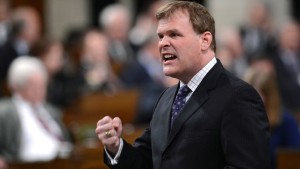 Baird: He can read the political polls and tea leaves. It is probable that Stephen Harper will not win a majority in this coming year’s election. He can read the political polls and tea leaves. It is probable that Stephen Harper will not win a majority in this coming year’s election. And it is possible that the Conservatives will end up in opposition. In either of these scenarios the famous Tory knives will come out and Mr. Harper will be on the plate.
So I’m betting that this walk in the snow is all about taking a break, a hall pass, so he can recharge his batteries, organize his supporters and get ready to come back refreshed, if not fresh – after Harper gets the big heave-ho. This was the game that worked for Jean Chretien and Jim Prentice. I’d mentioned that I never cared much for John Baird, neither as MPP nor MP. How do you think I’d feel about him as P.M.?
 Ray Rivers writes weekly on both federal and provincial politics, applying his more than 25 years as a federal bureaucrat to his thinking. Rivers was a candidate for provincial office in Burlington where he ran against Cam Jackson in 1995, the year Mike Harris and the Common Sense Revolution swept the province. Ray Rivers writes weekly on both federal and provincial politics, applying his more than 25 years as a federal bureaucrat to his thinking. Rivers was a candidate for provincial office in Burlington where he ran against Cam Jackson in 1995, the year Mike Harris and the Common Sense Revolution swept the province.
Background links:
Baird
Protecting Baird Open Secret More Baird Hydro One
Harper Needs Him Even More Baird Post Retirement Five Facts

 By Karina Gould By Karina Gould
February 4, 2015
BURLINGTON, ON
Every baker knows that making a cake is easy and predictable so long as you follow the recipe. It took me a number of years while growing up to figure this out. One day, however, when I was away at school, I decided to bake banana bread by the book. I precisely measured each ingredient in the recipe and voila – perfect banana bread.
 Karina Gould is a very direct person – little doubt what she thinks on a subject. Public will get to know her better when the federal election campaign begins in the Spring Now you may wonder why I’m telling you about my baking habits in a piece about the long-form census. Good question. Here’s my question to you: Could you imagine making banana bread with only 68.6% of the ingredients? You could argue that you’ll just make 68.6% of the recipe, right? Fair point. So how about we completely change the recipe and give you 68.6% of the total ingredients, but don’t give you proportional quantities to the recipe. You’ll take something out of the oven, but it certainly won’t be banana bread and it will be very hard to compare to your previous banana breads for which you followed the recipe.
That’s the issue with the abandonment of the long-form census: the 2011 National Household Survey (NHS) had a response rate of 68.6% and changed the questions asked; neither are we getting all of the ingredients or the right proportions when it comes to one of the most fundamental aspects of a well-governed country: understanding our societal make-up.
Recently, I spoke with the director of a local community development organization. The first issue she brought to my attention was the long-form census. “We don’t know who we are as a country anymore,” she lamented, “we can’t tell who needs services in our communities and whether those services are adequate.” Shortly thereafter I spoke with a high-ranking businesswoman, “I can’t identify potential clients because I have no idea what the current market make-up is.” The NHS results weren’t worth a penny she explained.
The elimination of the long-form census has had a significant impact on our country’s ability to make and plan good policies for the future. This isn’t an issue that impacts one particular segment of our society. This is pan-Canadian. The Canadian Chamber of Commerce, the Canadian Medical Association and numerous other organizations have endorsed a return to the mandatory long-form census.
The current government will tell you it’s about privacy. That was the argument they used in 2010 when they axed this basic foundational instrument of policy-making. It is ironic then that they are so keen to introduce their anti-terror legislation as well as their internet surveillance legislation neither of which seem particularly concerned with an individual’s privacy… it is noteworthy that Jennifer Stoddard, Canada’s privacy commissioner at the time, found the census was exemplary when it came to dealing with privacy concerns.
 Karina Gould is the federal Liberal candidate for Burlington. Finally, let’s think about costs. You’ve made your not-so-delicious, far from perfect banana bread and you now know you can’t serve it. So what was the point of wasting $22 million more than the cost of the long-form census on a voluntary survey with a low response rate and poor results? For a government that is committed to cutting cost and reducing waste, it seems they missed the mark on this file.
But TODAY, Tuesday, February 4th, there is an opportunity to fix this mess. Bill C-626, a Private Member’s Bill, will be up for second reading in the House of Commons. The opposition parties have committed to supporting it. Let’s hope a few government members will as well.
Not bringing back the long-form census, to me, is bananas. Bringing it back makescensus.
Karina Gould, is the Liberal Party of Canada candidate for the constituency of Burlington

 By Pepper Parr By Pepper Parr
February 4, 2015
BURLINGTON, ON
An email from a colleague said he was going to be in town – and could he buy me lunch.
The immediate answer was – of course you can buy me lunch – the follow up question was: What did he want?
James McLean, holder of a PhD in communications studies currently on a Sabbatical from Concordia University in Montreal, is working on his next book: Minority Media and the Journalistic Entrepreneur.
Lunch was relaxed; two old time media types swapping tales and working at impressing each other. I noticed there was a grey file folder on the table we occupied at Spencer’s on the Waterfront; it wasn’t very thick.
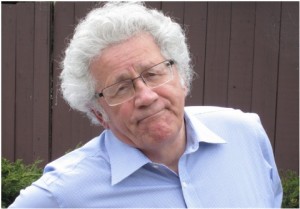 Academic wants the views and thoughts of an on-line publisher. Does he have any idea what he is getting into? Dr. McLean wants to include the Burlington Gazette as one of four or five on-line publications he will be researching. He is using on-line sites in both Canada and the United States doing in depth interviews a couple of times a year during which he certainly took us to task on some of the approaches we used. He also digs into the analytics and who our readers are; what they read, how long they stay on line and some detail on the demographics of our readers.
The waiter asked if we wanted our beverage glasses re-filled – McLean was picking up the tab so my answer was a quick yes – but I wanted to know what was in the file folder. McLean opened it up – he had a release he wanted me to sign giving him permission to use quotes from me in his book and to refer to some of our data.
The waiter was serving 9 oz. glasses of a very nice California Chardonnay so I of course said yes, reached for my pen and signed on the dotted line.
No publication date yet – but when the book does come out we will do what we can to get Dr. McLean back into the city; perhaps he can be a guest speaker at those Insight Burlington events the Mayor used to hold.
Heck – a book about Burlington’s on line media will help us keep that title of the Best Mid-Sized city in Canada. That should help – shouldn’t it?

 By Ray Rivers By Ray Rivers
February 2, 2015
BURLINGTON, ON
It’s a nice change to see gasoline prices down. We’re pretty used to them going the other way and tired of all the excuses offered by the oil folks for why they have no choice. Global political instability or natural disasters are the classics. When hurricane Katrina struck New Orleans the oil industry got to double-up on excuses, blaming both the natural disaster and the storm-related destruction of the refineries and oil platforms.
 Pipeline capacity was sometimes the reason for higher gas prices. Typically the oil giants claim their hands are tied, blaming inflated selling prices on the tax man, or the speculators – derivatives, futures and hedge funds. They spit out this line as if they are innocent, even though they do much of the speculating themselves. And when the economy is healthy and growing, it’s inadequate refining capacity, depleted oil fields and limited pipeline capacity that are to blame – as if the industry has no control over these factors.
The price of oil is currently of huge importance to us. We are a free-trading, transport-intensive economy built on the automobile. The price of oil can mean the difference between economic boom or bust. Those of us old enough will recall how the late 1970’s Arab oil embargo gave us third-world-style gas pump shortages. North America and the world were plunged into recession and then wrenched back into near hyper-inflation – and then into something called stagflation.
More recently in the run-up to the 2008 recession, oil prices skyrocketed towards $150 per barrel, becoming the proverbial ‘straw breaking the camel’s back’, and triggering the debt-driven economic collapse that year. But what goes up also comes down and the price declined to one third of its value as quickly as it had risen. Then, as night follows day, prices rose again in sync with the recovering economy.
Today most of us are cheering the prices at the pump. Some experts attribute this phenomena to Saudis flooding the market in an attempt to drive American horizontal drilling hydraulic fracturing (fracking) entrepreneurs out of business. Others speculate it is the Yanks and Saudis collaborating to inflict damage on the oil-export dependent Russian economy. Since almost a fifth of Russia’s GDP and half of its budget come from oil revenues, falling oil prices may be more effective than sanctions have been at stopping the armed aggression in Ukraine.
 Fracking has certainly had a huge impact on where Americans get the gas from – the damage to the environment is becoming a little clearer and it doesn’t appear to be good news. America used to be the world’s biggest oil producer, until the low-hanging fruit in the oil fields was nearly exhausted and cheap middle-east oil came begging for a market. Thanks to ‘fracking’ the US is poised to regain that title and become self-sufficient. Of course that has implications for Canada, given that the US is virtually our only export market.
The very first oil in North American came from a well in Ontario in 1858. Today production is largely from Alberta, Saskatchewan and Newfoundland. The federal government has supported the oil industry in one way or another over the years, including the governments of John Diefenbaker, Pierre Trudeau and Stephen Harper. In addition to direct subsidies and accelerated capital write-off, the government plays a significant role in oil transport, exploration, investment, international trade and environmental management.
But, if Stephen Harper saw the development of the vast ‘tar sands’ as a solution to the vagaries of Canada’s business cycle, he couldn’t have been more wrong. Oil is as volatile as… well just look at it today. And as the US becomes self-sufficient and even competes with Canada for export markets, that volatility will just get worse and markets dry up. And then there are the new supply-side technologies, such as ‘fracking’, which will enable countries from China to Ukraine to start producing more of their own oil.
What is really exciting, though, is demand-side technology. Electricity is a better alternative for propelling an automobile, whether in pure or hybrid vehicle format. Electric motors are safer, cleaner, virtually maintenance-free, more reliable, quieter, and more powerful – as we see with the Tesla all-electric sports cars or the economical Nissan Leaf. Electric vehicles were common-place in the mid 19th century, even holding the land speed record until the turn of that century.
Oil will always be part of our economy – for fertilizer, plastics, and the other myriad of uses – but 70% of all the petroleum used today is for transportation. And those days are limited. Even the lower pump prices we see today should not forestall the inevitable move away from petroleum. The smart money is on the alternatives.
We know the roller-coaster ride in petroleum pricing will continue, lifting prices again once the industry gets its act together following this current crisis. The oil industry is a largely unregulated oligopoly (limited number of sellers), and so long as they can work together (collude), and avoid political minefields, they will manipulate the market to their financial advantage. And we can expect to hear those old excuses crop up again as they do.
 Ray Rivers writes weekly on both federal and provincial politics, applying his more than 25 years as a federal bureaucrat to his thinking. Rivers was a candidate for provincial office in Burlington where he ran against Cam Jackson in 1995, the year Mike Harris and the Common Sense Revolution swept the province. Ray Rivers writes weekly on both federal and provincial politics, applying his more than 25 years as a federal bureaucrat to his thinking. Rivers was a candidate for provincial office in Burlington where he ran against Cam Jackson in 1995, the year Mike Harris and the Common Sense Revolution swept the province.
Background links:
Energy 101
Oil Busts USA Oil Price of Oil
Shale Gas US Energy Reserves Canada’s Energy Policy
Oil Sands Environment Tesla

 By Mark Gillies By Mark Gillies
January 22, 2015
BURLINGTON, ON
Part 2 of a 2 Part feature
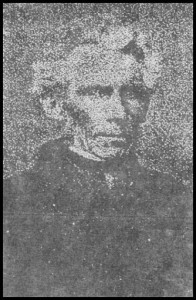 Peter Carroll 1807-1876 was a wealthy man, a land surveyor, a co-founder of The Great Western Railway, and a businessman who served on many corporate boards. When Rock Bay opened, it was spectacular to see. Peter Carroll had selected an ideal location for the mansion, overlooking Burlington Bay from the north shore line located at the far western end. Below the mansion sitting high atop its high ground, was a jut of land that ran way out into Burlington Bay. This land was to be known as Carroll’s Point, and the name is still in use today. You could say that Peter Carroll’s closest neighbour, towards Hamilton, was Sir Allan MacNab, who lived in nearby Dundurn Castle.
Peter Carroll loved to entertain. His wife was the former Henrietta Martin. They married in 1836. Together they entertained the wealthy and put on countless lavish galas. Most guests at the time lived in Hamilton, and they would ride to Rock Bay Castle in their fancy carriages from the city out to Peter and Henrietta’s estate, horses prancing along York Boulevard, across the Burlington Heights, turning right at the Valley Inn Road, proceeding down the hill, and then driving up to the front gates which were located just about where the Woodland Cemetery main entrance is now.
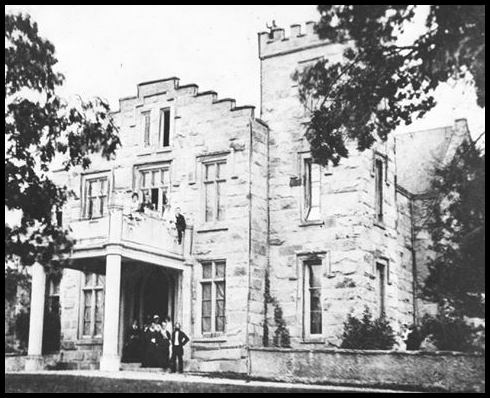 Rock Bay Castle was a mansion in Aldershot owned by Peter & Henrietta Carroll, a venue for high society galas. Guests, in this photo, can be seen enjoying themselves at Rock Bay Castle. The lane way to Rock Bay was long and it was winding. Colourful gardens adorned both sides of this beautiful lane. Peter had oak trees planted on either side of the lane. Over time, the oak trees provided a covered arch, all the way to the handsome port cochere. Many of these trees can still be seen on the Woodland Cemetery grounds. Stepping out of the carriage upon your arrival, there were many servants tending to your every need. As you walked up the steps to the front entrance way, the great wooden door would be opened for you, and then you entered into a beautiful wood paneled hall, and proceeded to one side into a circular reception hall, graced with a large fireplace. In the fireplace would be a fire, well-seasoned oak logs would be crackling and burning. This reception hall was 2 storeys high, and to one side was a circular staircase that led you up to a balcony with a window that overlooked the estate’s property.
From this same balcony room, several doors would lead you into the bed chambers. Rock Bay had a beautiful drawing room, and within it was something quite rare for Upper Canada at that time. It was a beautiful grand piano. The windows in the mansion were adorned with heavy curtains of brocade. To light the estate in the evening, scented candles were found to be everywhere. Beautiful family portraits painted in oil were hung on most walls inside this magnificent home. Rock Bay was breathtaking.
The focal point of Rock Bay was the exterior’s large square tower, similar to one seen on Scottish baronial castles.
When you were either entertained at Rock Bay Castle, by Peter & Henrietta Carroll, or at Dundurn Castle by Sir Allan MacNab, guests knew they were in a special circle of the elite, and from this, they had a chance to enjoy the benefits of high society.
 Peter Carroll’s monument is in historic Hamilton Cemetery. Peter died from small pox in 1876. His legacy is now forgotten. While Peter Carroll was on a business trip to France in 1876, he managed to contract small pox. When he returned home, he tragically died a few days later on September 18th. Henrietta, herself contracted small pox from Peter, but survived this attack. Peter was buried in Hamilton Cemetery. However, the importance of Peter’s death and his funeral were overshadowed by another event that captured all of the headlines in Canada and the United States. A man from Hamilton, named Cyrenius Chapin Roe, a machinist by trade, unveiled his invention that totally captivated everyone. Cyrenius was more commonly known as C.C. Roe, and his invention was patented as “Steam Man”.
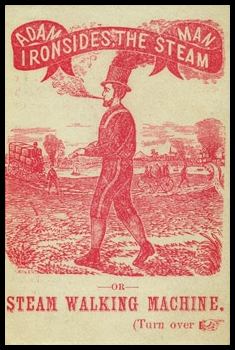 C.C. Roe from Hamilton invented the world’s first robotic man, called “Steam Man”. It took North America by storm. Many events of real importance at that time were relegated to the back pages of newspapers. This was the world’s first robotic man capable of walking upright, and “Steam Man” could perform feats of strength. The world was captivated by this man’s invention, spawning many articles and stories everywhere. C.C. Roe and his family travelled all across Canada and the United States with “Steam Man”, as people flocked to see this marvel of modern technology for themselves.
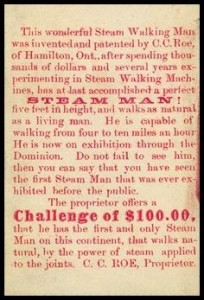 Henrietta, after recovering from small pox, continued to live at Rock Bay. When she became too elderly to live there on her own, she went to live in Hamilton. Henrietta, after recovering from small pox, continued to live at Rock Bay. When she became too elderly to live there on her own, she went to live in Hamilton.
There, Henrietta died of senile debility on July 20, 1907. While Henrietta, as a widow, was still alive and living at Rock Bay, my own grandmother Mabel Henrietta Hunter and her sisters, Lydia, Maud, Nellie, Ethel, Edna & Jessie, as young girls in the 1880s and early 1890s would play at Rock Bay with the jovial elderly lady. Henrietta Carroll taught the young girls how to make various crafts.
My great grandfather, Arthur Hunter, was an original Aldershot market gardener, and the Hunter family lived in Peter Carroll’s Bay View cottage as tenants. When my grandmother was born in 1883, it was at Rock Bay mansion. My great grandparents, Arthur & Elizabeth Hunter gave Mabel, my grandmother, the middle name Henrietta, in honour of Henrietta Carroll, a lady who was quite adored by the Hunter family.
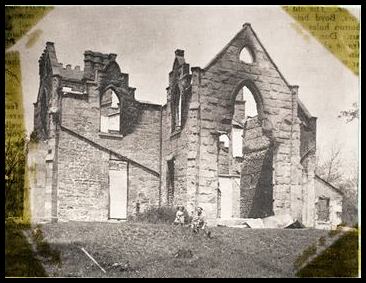 Rock Bay Castle suffered the fate of a devastating fire. Henrietta Carroll lost everything. The building was eventually demolished. The stone walls were crushed into gravel. And what became of Rock Bay? Sadly, this beautiful mansion burned to the ground around 1908. The stones from the building were crushed into gravel. Some say, that this same gravel was used for the new roads winding throughout Woodland Cemetery. This could be true, I do not know.
As for the name Rock Bay, where did that name come from? No one knows for sure. Some say, it was named after Peter Rock, who owned the Maple Leaf Hotel, located in the Market Square in Hamilton. I don’t believe that is true.
Peter Rock did not arrive in Hamilton, until around 1890, many years after the death of Peter Carroll. My own theory is, it was a combination from two sources. “Rock” could have been in reference to the stone from Queenston, used to build the mansion’s walls, and “Bay” would have been the reference to Burlington Bay.
What’s really unfortunate is Rock Bay Castle, this beautiful mansion from the 1850’s is no longer with us. We lost a beautiful jewel from the past.
Mark Gillies will next tell you about Harry Lorimer, another forgotten person from Burlington’s colourful historical past. A humble man, Lorimer made a huge impact on Burlington, not just once, but twice. Lorimer’s house at 504 Burlington Avenue was recently removed from the City’s Heritage Registry for lack of historical significance, a decision many find totally incomprehensible, myself included.

 By Ray Rivers By Ray Rivers
January 29, 2015
BURLINGTON, ON.
Writing this year’s budget is a challenge for federal finance minister, Joe Oliver. His predecessor, the amiable Jim Flaherty had left us believing the government would be finally riding its way to a balanced budget, with possibly some new tax cuts thrown in this year. But the PM, hoping to counter negative polling, jumped the gun and offered up almost $5 million in new cuts and spending, including $2 billion in cuts mostly for the wealthiest families.
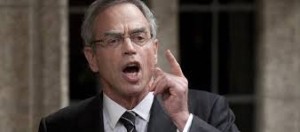 Minister of Finance is in way over his head – Prime Minister may have pushed him under a bus. The problem is the price of oil. Oil is vital to the functioning of today’s modern economy. One would think we’d all welcome a drop in its price, especially those who drive cars. Falling oil prices are actually better than a tax cut for consumers, since it is immediate. I will be discussing this in more detail in my next column.
Suffice it to say that, generally, if the cost of a factor of production, like oil, falls, corporate net income (profit) should rise, except for the oil companies. And consumers with more money in their pockets after filling-up, can be expected to spend it, thereby boosting the economy and creating new taxable employment. All of this should make the budget balancing act easier, and maybe even generate a surplus, you’d think.
But it isn’t working out that way. For one thing the Conservatives cut the corporate income tax rate from 19% in 2009 to 15% today, presumably to encourage greater investment. But that was money for nothing, because investment in Canada has fallen rather than increased, and with it so has productivity. Cutting corporate taxes was a failed proposition federally, as indeed it was here provincially – also contributing to Ontario’s deficits.
When oil prices were flying high, at over $100 per barrel, the taxes from the oil industry more than made up the shortfall – but that was then. Today the oil companies are barely breaking even mining the tar sands. Still the silver lining of low oil prices is that our falling Canadian dollar should make us more internationally competitive. However, as I outlined in my last column, it may take years to revive the non-oil economic sectors of the Canadian economy.
 Governor of the Bank of Canada gave Oliver a gift recently by cutting the bank rate. So with federal revenue down, how does Mr. Oliver balance the budget? Financing Canada’s debt costs us almost $30 billion annually. The Governor of the Bank of Canada gave Oliver a gift recently by cutting the bank rate, thus potentially lowering the cost on new financing. But our declining US exchange rate neutralizes much of that because some of the debt is held by foreigners in US denominated securities- and that costs us more as our dollar falls.
Having just cut taxes, this government is unlikely to raise them again, so the Finance Minister has to look at the cost side of the equation. We should expect more service cuts, further compromising services in immigration, veterans affairs and the military. Don’t be surprised if new taxes appear disguised as user fees, such as more costly park permits, passport applications, etc.
Most likely there will be further deferrals of major capital investments and acquisitions, such as fighter aircraft and arctic patrol ships. Lumping this year’s expenditures into next year’s budget is a favourite shell game of a government in trouble – it’s called creative financing. And expect to see whatever is currently left of the departments of Environment and Natural Resources get further hollowed out.
Of course the Minister may decide it is time to sell off more Crown land, airports or other physical or intellectual property. We have started bunking-in at some foreign embassies, and we should expect that trend to continue, despite the obvious complications for diplomacy and sovereignty. Foreign aid, such as it exists today, might be further wound down – after all U2’s Bono was Paul Martin’s friend.
 It was the tar sands that were going to save our economic bacon – then the Saudi’s changed the game. It could happen – Mr. Harper might claim a balanced budget, even with the extra billions he prematurely slashed from the revenue side. Balancing the budget is a point of principle for the PM, one that he expects will define him and his leadership. But unless the price of oil rises substantially to somewhere close to $100 a barrel soon, showing up with a balanced budget would just be a lot of smoke and mirrors. And the longer the PM waits to announce that budget the harder it will be to justify the numbers.
Keynesian economics says we should pay off the debt in good times so we have borrowing room in the bad times. It has been almost seven years since the 2008 recession hit and this PM got to preside over the largest deficit in the nation’s history. So it has taken a long time to even get close to his goal of being in the black, notwithstanding all the chatter.
In the end, Mr. Harper may well claim a balanced budget, even taking us back to the kind of surplus he inherited when he first became PM. Of course the real question is whether the electors are better off now than they were in 2006? For some the answer is clearly yes. But for the many who find themselves on the other side of that ever-increasing spread between the wealthiest ten percent of Canadians and the others, the answer is not so simple.
 How does the Minister of Finance create an economic pie big enough for everyone to eat? For those middle and lower income Canadians, who make up the vast majority of our population, it is the size of the economic pie and their share in it that matters. And so it is high time that our government started addressing the issue of economic inequality – the distribution of wealth in this country. We could look to Mr. Obama’s recent ‘State of the Union’ address as a starting point for that discussion in Canada.
 Ray Rivers writes weekly on both federal and provincial politics, applying his more than 25 years as a federal bureaucrat to his thinking. Rivers was a candidate for provincial office in Burlington where he ran against Cam Jackson in 1995, the year Mike Harris and the Common Sense Revolution swept the province. Ray Rivers writes weekly on both federal and provincial politics, applying his more than 25 years as a federal bureaucrat to his thinking. Rivers was a candidate for provincial office in Burlington where he ran against Cam Jackson in 1995, the year Mike Harris and the Common Sense Revolution swept the province.
Background links:
Harper Tax Cuts More on Harper Tax Cuts Pay Back the Debt
More on Debt Investment
Previous Rivers Column on how the PM sees the Canadian economy. Obama’s Take on Equality

 By Mark Gillies By Mark Gillies
January 27, 2015
BURLINGTON, ON.
Part 1 of a 2 part feature
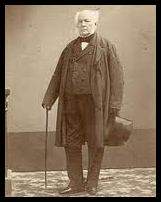 Sir Allan Napier MacNab was a wealthy lawyer, a Prime Minister, a co-founder of The Great Western Railway, including business partner and close friend of Peter Carroll. Here’s a question for you. When Hamilton’s Sir Allan Napier MacNab the wealthy Prime Minister of Upper Canada, from 1854 to 1856, went dining at a castle in Aldershot, where did he always go?
If you said, Rock Bay, consider yourself a genius. If you have never heard of Rock Bay, don’t feel bad, you are not alone. This is just one more of Burlington’s greatest treasures, regrettably, forgotten over time.
Rock Bay was the first stone castle-like mansion built in the Aldershot area during the early 1850s, by one of Canada’s wealthiest men, Mr. Peter Carroll. Many at the time referred to his residence as Carroll’s Castle, because it did resemble a castle.
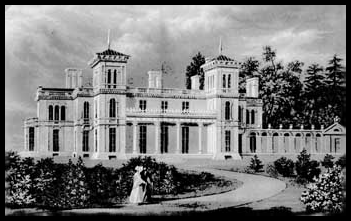 Dundurn Castle was built for Sir Allan MacNab and completed at a cost of $175,000 in 1835. This artist’s impression shows us what Dundurn Castle looked like in this same year. Dundurn Castle, which we are more aware of, is located at the western end of Burlington Bay on land named Burlington Heights. This beautiful grandiose home built for Sir Allan MacNab, over a 3 year period, was completed in 1835, at a cost of $175,000. We just don’t know about its neighbour, Rock Bay Castle, nor do we know much about Peter Carroll.
What was it that these men had in common? Allan MacNab and Peter Carroll both attained enormous wealth and great power. They were best of friends and business partners. Allan MacNab was a lawyer, but amassed his wealth in land speculation. Peter Carroll was a land surveyor by profession, eventually retiring from this field, in favour of establishing a construction company that built and owned major toll roads across the colonial province. To say the least, this career move was extremely lucrative. Road construction and tolls were the catalysts that launched Peter Carroll into new wealth. Among the many roads in Upper Canada that Peter constructed and owned were these familiar local routes; Waterdown Road, Plains Road (then called the Hamilton and Nelson Gravel Road) and Carlisle Road, plus most roads surrounding Hamilton. Before retiring from land surveying, Peter was responsible for the creation of the grid pattern street layout in Hamilton, a contract offered to him by his good friend, George Hamilton, the founder of Hamilton, Ontario. Peter, under a similar contract, also surveyed the entire Burlington Bay.
Three great minds work together to amass their fortunes
Allan MacNab and George Hamilton were already longtime boyhood friends, both born and raised in Niagara-on-the-Lake. These two men rose to prominence mainly from their efforts in battles during the War of 1812. Helping to defeat the American invasion at Queenston was their crowning achievement in the military. Allan MacNab was knighted by Queen Victoria. Peter Carroll served as a lieutenant-colonel in the militia in these same battles. This is most likely where he first met the other two men, prior to all three setting out seeking fame and fortune after the war ended.
It was basically these three men, after the war, who worked together to shape the future of Hamilton, plus the surrounding areas, including Aldershot. All three men acquired massive tracts of land in this same area, and even abroad. Peter Carroll for one, had extensive land holdings in Iowa and Illinois. All of this land provided the three landowners with unbelievable wealth. These three men influenced the future direction for the Province of Upper Canada, mainly through politics.
Peter Carroll selects a beautiful setting to build his mansion
A spectacular view from Burlington Heights looking east towards Lake Ontario, was the best property for Allan MacNab to build Dundurn Castle. Peter Carroll, not to be outdone, one day, also wanted to have a palatial home with a view overlooking the same Burlington Bay. Unfortunately, the Dundurn Castle site was already taken. As Peter continued to work his way into the power brokers’ circle, with his wealth continuing to dramatically increase, he finally decided it was time to build, and purchased a 40 acre tract of land on the northwest side of Burlington Bay.
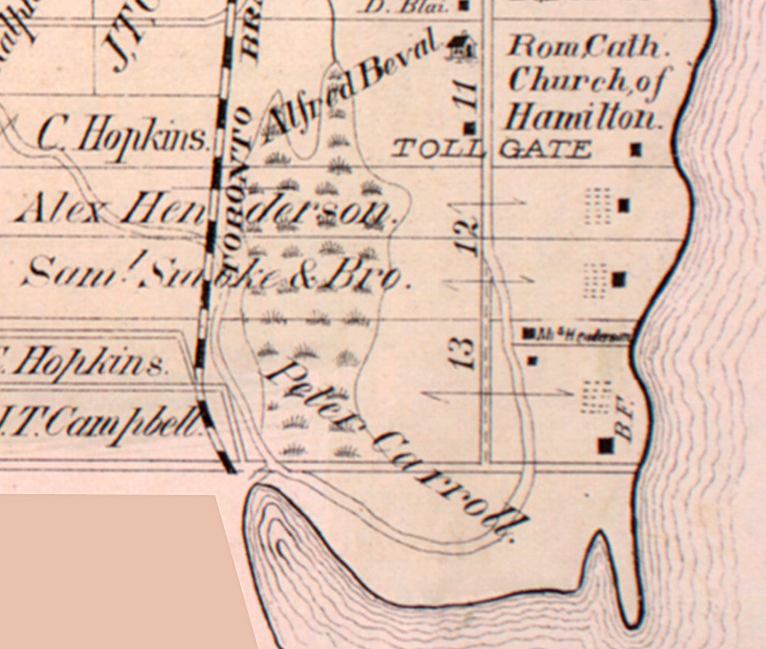 This old land map shows us where Peter Carroll’s property was located in Aldershot. Today, the same property is where Woodland Cemetery, the Royal Botanical Gardens and the Plains Road curve are located. It was not uncommon for men of great wealth to showcase their success with massive homes. Peter was shrewd enough to not upstage his friend and mentor, Sir Allan MacNab, by building a larger mansion, despite possessing enough wealth. Peter’s home would be on a smaller scale, but would resemble a castle in England. Peter hired an English architect who specialized in manor homes. The architect was brought over to design his new home. The land that Peter Carroll purchased is now occupied by Woodland Cemetery, the Royal Botanical Gardens, and the Plains Road curve in front of the RBG headquarters. The massive stone structure began its construction in the late 1840s. Cut stone was shipped in from a quarry located in Queenston. The mansion was finally ready for occupancy in 1855. The beautiful estate featured a port cochere, stables, outbuildings, a mammoth entrance gate, and small guest lodges located just inside the gates.
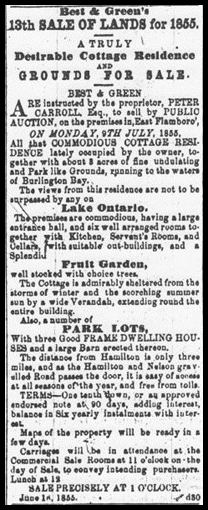 The Bayview cottage was put up for sale by auction in 1855 when Rock Bay was ready for occupancy. The advertisement describes the building, and the grounds available for purchase. Part of the estate was set aside for farming. Peter Carroll has been identified as one of 2 people to introduce commercial peach farming into Upper Canada. Oak trees were planted on either side of the long winding drive heading towards the mansion, beginning when you turned off from the Hamilton and Nelson Gravel Road. Many of these same oak trees planted on Peter Carroll’s estate are now over 160 years old, and if you position yourself correctly on the grounds of Woodland Cemetery, it is possible to follow the route of the original laneway right to the front entrance of Rock Bay. Peter’s first home in the area, was an oversized board & batten wooden cottage, called Bayview. This building was located on the same property, and was constructed a few years before the mansion was built. When Peter was ready to move in to the larger premises, Bayview was put up for sale by auction.
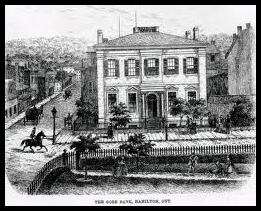 Peter Carroll was on the Board of Directors for several corporations, including the Gore Bank. This drawing is the Gore Bank office in Hamilton. Peter Carroll sits as a Director on two different banks
As Peter became more influential and powerful, he was invited to be on the Boards of several corporations, including the Bank of Brantford and the Gore Bank. In those days banks issued their own currency in the form of bank notes, but they were actually promissory notes.
A Great Western Railway “Founding Father”
While the mansion was still under construction, and even after Peter Carroll moved in, Sir Allan MacNab and Peter Carroll continued to move along fairly quickly in the business world. They believed a railway was needed to help open up southwestern Upper Canada for more European settlers who were arriving in increasing numbers.
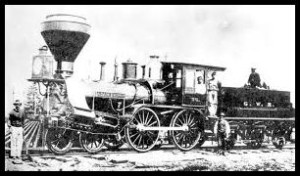 The Great Western Railway built train stations, bridges and track all across southwestern Upper Canada. This is a rare photograph of a very early Great Western Railway locomotive, tender and cars. One of the greatest achievements for these men, was to finally receive a charter from The Parliament of Upper Canada in 1845, to create the Great Western Railway, 7 years before The Grand Trunk Railway was incorporated in 1852. The new railway company began construction of trains stations, rail lines and bridges, mainly in southwestern Upper Canada. Rail service began in 1853. Sir Allan MacNab became President, and a group of men, mainly prominent lawyers, including Peter Carroll formed the first Board of Directors.
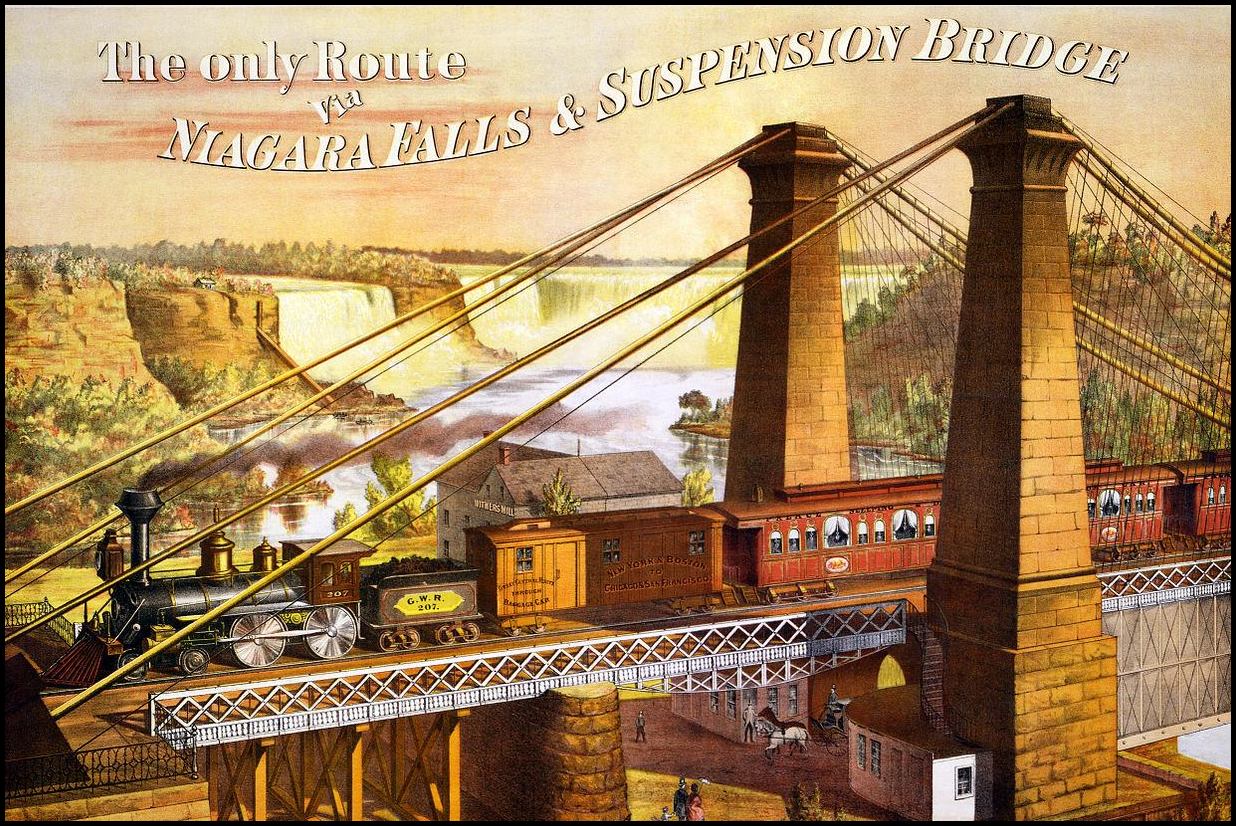 The Great Western Railway was the first in Upper Canada to establish itself as a major player in the market. The drawing of the suspension bridge, a marvel for its time, shows a GTR train crossing. Peter Carroll was on The Board of Directors for the Niagara Suspension Bridge Company and The Great Western Railway Company. The Niagara Suspension Bridge
Even back in the early 1840s, before their railway charter was awarded, these men realized accessing the bigger American market was going to be key for their financial success. The Great Western Railway Board believed the rail line should one day connect to the United States by a bridge. With that decision made, Peter Carroll became a Director of the Niagara Suspension Bridge Company of Canada. The International Bridge Company of New York was the second company involved with the bridge construction. The two companies would have joint ownership. This first railway suspension bridge in North America was built across the Niagara Gorge, an expanse of 800 feet. The suspension bridge when it opened in 1855 was considered to be an engineering marvel, for its time.
In part 2 of this 2 part feature find out what happened over 100 years ago to this beautiful castle-like mansion. over 100 years ago? See 2 very rare old photographs of what Rock Bay Castle looked like. Whatever happened to Peter Carroll? Why is he not in the history books?

 By Pepper Parr By Pepper Parr
January 26, 2015
BURLINGTON, ON.
There just might be an opportunity for pilot private tree bylaw in the Roseland community.
Last week the Roseland residents met to learn what the city planning department was going to do with the recommendations made by the consultants who conducted the community character study that is now complete.
The character study done in Roseland was one of two the city had done. It wasn’t possible to arrive at any sense of consensus on the Indian Point community character study but there was much to work with in Roseland where residents resent developers buying up properties, clearing the land, demolishing a home and then seeking a variance at the Committee of Adjustment to sever the lot and build homes that many feel do not fit in with the look and feel of the community.
 A tree close to 100 years of, `honoured`by the community was cut down. The property owner has plans to seek a severance of the property. Roseland residents furious that things like this are allowed to happen. One of the issues is the cutting down of trees that are on private property. City council was not able to get a private tree bylaw passed during its last term of office. Mayor Rick Goldring was on for such a bylaw and there were several cogent, persuasive fact filled presentations made at the time but it wasn’t enough to get the four votes needed.
The Roseland residents might have created an opening for the Mayor who sat in on the meeting last week – and got more than an earful.
There was a superb opportunity for the Mayor to put forward his belief in the need for a private tree bylaw. He was given close to the last word during the meeting of residents and he made his typical comments; that he heard what they were saying and more yada, yada, yada. He did say a pilot tree bylaw was an intriguing idea. There was not even polite applause for the Mayor.
Jack Dennison, ward Councillor for the community then stood up and made his comments; thanking the planning staff and adding that it had been a productive meeting.
 Nothing unhealthy looking about this tree. Dianne Bonnell said “the level of residents’ frustration was palpable”, while another resident called the cutting down of trees an “absolute travesty” and left the room minutes later.
The residents at the meeting believed that the cutting down of 100 year old trees devalues the property of all the residents in the community and they are left feeling helpless. Some are beginning to move out of the community – they think the end of the Roseland they had chosen to live in was in sight.
What our Mayor could have done was this – told the community that he understood their frustration and that he was going to put a motion before council asking for a pilot private tree bylaw that would be restricted to the Roseland community and be in place for a number of years – three should do it.
The Mayor could have then turned to Councillor Dennison and asked him publicly if he would support such a motion.
But Rick Goldring doesn’t have that level of political chutzpah and for the next while majestic oak trees will be felled in the Roseland community.
It was a lost political opportunity for a Mayor who appears to have a tin ear when it comes to listening to the residents.
Related articles:
Council votes against a private tree bylaw.
Community survey doesn`t convince city council that private tree bylaw is needed.

 By Pepper Parr By Pepper Parr
January 26, 2015
BURLINGTON, ON.
Ray Rivers, our political columnist is in New Zealand – spending as much time as he can fishing.
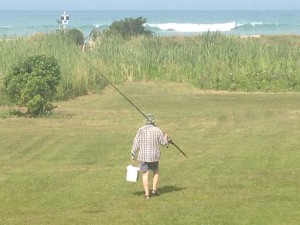 Gazette political columnist heads for the ocean hoping to catch enough fish for a family dinner. He kind of likes the idea of not having to shovel snow. Through the magic of the internet he is able to keep up with events in Canada and will write next about the difficulties a delay in delivering the budget means to everyday people.
Budgets are complex documents and involve every department of the federal government. The change in world oil prices has created close to total havoc with the budget the federal government was expected to deliver in March.
Rivers was a federal bureaucrat for more than twenty years – he has worked on putting together the operating level of budgets for several departments. Later this week he will talk about just what is probably going on within the federal bureaucracy. His political experience allows him to explain how a government puts a spin on a budget.
The impact of those oil price changes are spinning everything for governments around the world. They just might force Alberta into creating a sales tax – and once that tax is in place it might never get lifted.
Big changes – Rivers will write about them in his next column.

 By Ray Rivers By Ray Rivers
January 20, 2015
BURLINGTON, ON
For a long while now I have criticized the federal government’s approach to managing the economy – focusing on energy exports to the exclusion of the rest of the economy.
Given the recent collapse in the global petroleum market and the United States move towards energy self-sufficiency, it is now apparent, even to the Prime Minister, that such a narrow-minded economic policy was short-sighted and dangerous.
So a new Stephen Harper is emerging, one desperately interested in doling out economic subsidies to a forgotten domestic manufacturing sector. Incentives to encourage a more diversified economy, which he now appears to appreciate, are crucial, not only for the economic health of Ontario and Quebec, but for the entire nation as a whole. So much manufacturing capacity has been lost over the past decade that today’s manufacturing sector is simply unable to make up the shortfall in national income lost by the oil exporters.
 Massive trucks haul earth that is laden with oil that has to be processed before there is a usable product. Low oil prices make this kind of operation uneconomical. Harper wasn’t the only one sleeping at the switch, thinking he could slip his way to prosperity on the petroleum gravy train. His nemesis, Russian president Putin, used his vast oil money to build his military instead of diversifying the Russian economy and now is in an even worse pickle than Canada. And then there is Mr. Harper’s former environment minister, now Alberta’s premier, who is facing a budget deficit and considering an Alberta first – a sales tax.
Not long ago, Canada had tried to bully the US into building the Keystone XL pipeline, hoping to reach Asian and European markets easier that way. But US :President Obama resisted our PM and it turns out he knew what he was doing. Nobody is going to buy dirty Alberta oil which costs more to produce than the $50 a barrel price today.
The new Republican controlled congress may still force Obama into that pipeline anyway, though I’m betting on Obama.
 Will these pipes every get buried and carry gas or bitumen to Texas or the Gulf of Mexico. The Alberta government certainly hopes they will – the environmentalists hope they get carted off somewhere else. It’s a legacy thing with the US president. Stopping Keystone, and slowing oil sands development, could be one of the few things Obama would have accomplished to help mitigate global climate change, after doing so little on that file during his eight years in office. On the other hand, Stephen Harper has done absolutely nothing about this issue.
Oh sure greenhouse gas (GHG) emissions in Canada dipped thanks to the 2008-2010 economic recession – but, as Bill Clinton would say, that was the economy stupid. The PM likes to claim Ontario’s renewable energy and coal phase-out reductions as his, though they were made without a lick of federal support.
This PM treats anything to do with the environment as anathema. For example, the Canadian government has recently shocked the rest of the world by objecting to the protection of 76 species being added to the Convention on International Trade in Endangered Species (CITES).
 Doesn’t look like oil – but once filly processed it will fuel your car – the question is at what cost to the environment. The environment should not be an ideological issue. A sustainable global environment is no more right or left than is a healthy growing economy. Yet climate change deniers continue to dominate conservative media and politics, denying what is plainly in their faces; that last year was the warmest on record, that the polar ice caps are melting faster than ever, and that ocean water levels are rising quicker than anyone ever predicted.
It was this PM who shredded the federal Environmental Assessment Act and gutted the time-honoured Fisheries Act in order to expedite more oil-sands development. And having promised to regulate oil-sector GHG emissions, again and again, he has repeatedly refused to do so. In fact, Canada, for the third time in a row, is trying to stop our North American free trade partners (NAFTA) from investigating the environmental effects of the huge tailings ponds created for Alberta’s oil sands.
Canada’s overall contribution to global GHG emissions is relatively modest, given our small population, but those emissions are more than proportionate when compared to many more populated nations. Brian Mulroney, one of Canada’s most environmentally oriented leaders, set this nation on a course to lead the world on the climate change issue back in 1992. Today’s Conservative government has relinquished that leadership and abdicated our responsibility to the planet by pulling out of the Kyoto Protocol and attempting to disrupt other international efforts to cut GHG emissions.
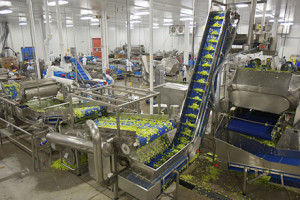 Manufacturing and product processing can become a solid core for the Ontario economy – if the needed investments in technology are made. It was during Mulroney’s time that Canada embraced the concept of sustainable development, originally defined by the Brundltand Commission in a report to the UN, titled “Our Common Future”. ‘Development that meets our needs without compromising the ability of future generations to meet their own needs’. The rate of development of the oil sands is spectacular and it would be even more so were the Keystone in place and the price of oil higher.
As the PM now realizes, tempering the energy extraction business and promoting a diverse and balanced economic growth and development strategy would have made the nation and his government less vulnerable to the vagaries we are seeing today. It would also have helped in meeting even the modest climate change targets we have set for ourselves.
 Ray Rivers writes weekly on both federal and provincial politics, applying his more than 25 years as a federal bureaucrat to his thinking. Rivers was a candidate for provincial office in Burlington where he ran against Cam Jackson in 1995, the year Mike Harris and the Common Sense Revolution swept the province. Ray Rivers writes weekly on both federal and provincial politics, applying his more than 25 years as a federal bureaucrat to his thinking. Rivers was a candidate for provincial office in Burlington where he ran against Cam Jackson in 1995, the year Mike Harris and the Common Sense Revolution swept the province.
Background links:
Canada’s Economy Economy Manufacturing Sector
Alberta Recession
Economy and Interest Rates Potential Carbon Pricing Hottest Year
Endangered Species
NAFTA and Oil Sands Rising Oceans Sustainable Development

 By Pepper Parr By Pepper Parr
January 19, 2015
BURLINGTON, ON.
The city did another photo opportunity last week.
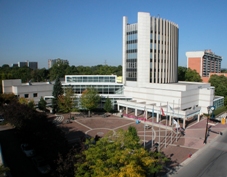 Opened in 1965, expanded later the structure no longer meets the space needs of the city. Are there real plans for a replacement? There is a report being worked on that sets out the needs and the possibilities. The occasion was to commemorate the 50th anniversary of City Hall’s opening as the Civic Administration Building in 1965. A plaque was unveiled telling of the founding of Burlington.
The brief ceremony took place on one of the coldest days of the year when Wayne Kelly, Manager of Public Education and Community Development at the Ontario Heritage Trust delivered some remarks. Residents were invited to attend the event.
It is doubtful if there was any mention of how inefficient the building is or that it can’t hold all the people the city employs.
The Gazette didn’t cover the event – this Council didn’t need another photo opportunity.
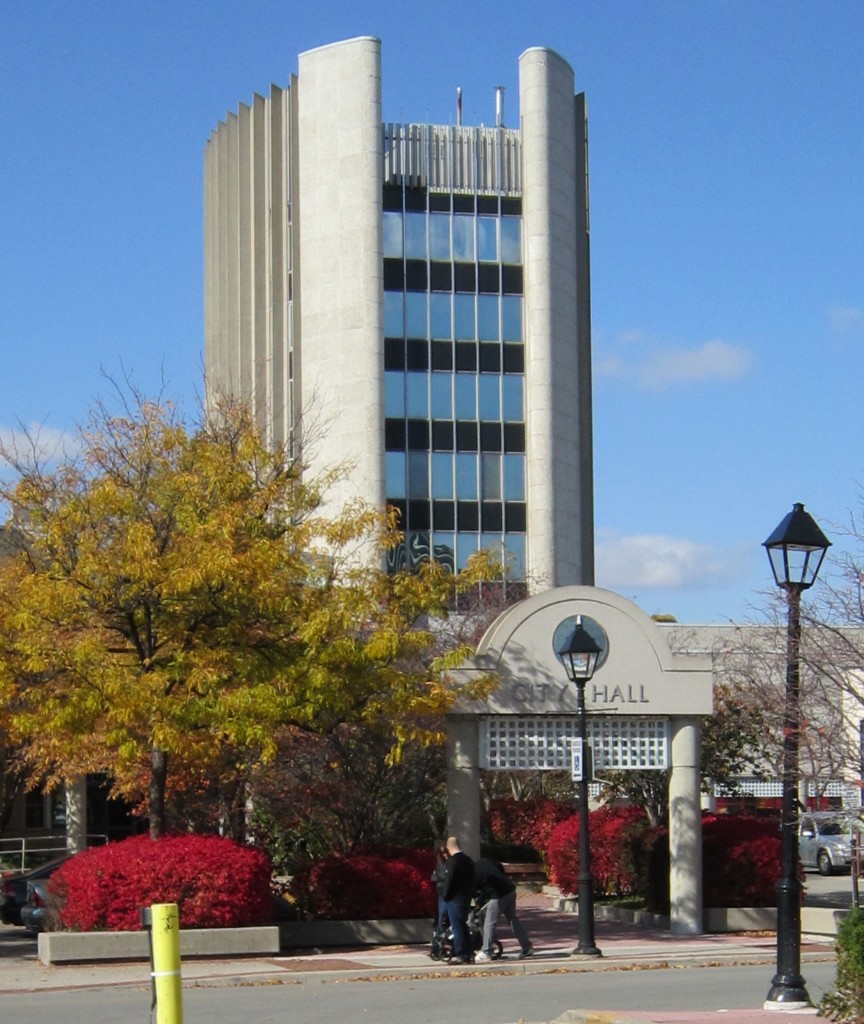 The building was a big deal back in 1965 – today it is too small and inefficient. What we are waiting for is the report that has been moving from desk to desk at city hall on the study of what the city has in the way of space it either owns or rents and what it is going to need in the way of space for the next 20 years.
The city currently rents space in the Sims building on the south side of Elgin where Human Resources, Finance, Purchasing, Legal and Capital Infrastructure beaver away on your behalf.
At one point it looked like the report was going to be made public before the election. Keeping that information away from the public was a smart political move and it maintained the practice of being opaque rather than transparent alive and well.
Former city manager Jeff Fielding had all kinds of ideas about where a city hall should be located and, had he stayed and completed his contract, there would have been all kinds of activity – that was just the way Fielding worked.
The file has been in the hands of the Capital Infrastructure people – once Council decides on who they want as a city manager it might see the light of day. For the time being the best citizens are going to get is some words from Wayne Kelly about how the city hall we have now came to be.
 The Sims building is more efficient than city hall. The city has leased space in the structure for some time; paid enough in rent argues Councillor Jack Dennison to have paid for the thing. The lease on the Sims building is due for renewal this year. There will probably be a short term lease renewal while the city gets its act together. The owner of the Sims building will push for a bit more than a short term renewal; they need the city as a tenant – at least until the Economic Development Corporation brings a company to town that will hire people for those high-tech, high paying jobs the city drools about having.
 The HiVe, one of the smartest ideas to settle in the downtown core has found that its costs are more than its revenue – they plan to move. The support they could have and should have gotten from the city just didn’t appear. Meanwhile The Hive over on Elizabeth Street, one of the smarter ideas to settle in the downtown core, has found that the rent they have to pay is more than the revenue they are bringing in – so they will be leaving the core and looking for digs that are less expensive.
None of this got mentioned during the plaque unveiling or while people were enjoying the refreshments at city hall.

 By Ray Rivers By Ray Rivers
January 12, 2015
BURLINGTON, ON
Stephen Harper has been PM since 2006, almost a decade. Although there have been longer-lived governments, his is looking particularly tired these days. The enthusiastic thrust to re-engineer Canada’s Senate, by a younger-day Stephen, has fallen off the face of the earth.
 Harper can be very combative – he gives as good as he gets. Canadians have a very significant decision to make in October of this year. Likewise, the PM’s zeal to transform Canadian society and re-mould it into the image of the US Tea-Party has mostly run out of steam. And the consequences of ideologically-driven gutting of the Public Service, to make it smaller, are coming home to us in the form of dangerously poor food inspection, back-logged immigration files, failing rail safety and neglected war veterans.
With an economics graduate at the helm, one would expect Canada’s economy to be cruising along closer to an A rather than the middling C we see today, or the D we expect in the future as oil prices continue to tank. Putting so many of our eggs in the petroleum basket has turned out to be a foolish ploy, even for oil-rich Alberta.
And despite all the ballyhooed cost-cutting, this government has run up as much debt as Pierre Trudeau did in all his years in office, though still not as big a hole as the one Brian Mulroney left us. Should the PM manage to balance the 2015 budget he would still have presided over 7 years of deficit budgets. And the Tories’ only two surplus budgets were handed to them on a platter by former Finance Minister, Paul Martin.
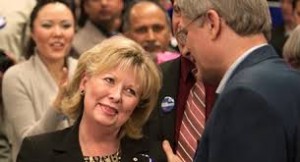 Senator Wallin and Prime Minister Harper during better times. Yes, there was a recession and Mr. Harper reluctantly opened the national purse when our economy hit the skids in 2008, giving Canada its highest deficit ever the following year. Harper became a convert to Keynesian economics as did other nations which came out of the recession relatively quickly. And Canada’s banking system was able to withstand the kinds of shocks that crippled inferior systems in other places, like the Eurozone.
 Stephen Harper in Calgary earlier in his career. But Keynes would never have advised shameless waste, such as Canadians experienced with the $1.2 billion Harper poured into the one- week G20/G8 party for world leaders in 2010. And the money? Well It pretty much went into that artificial lake, built right on the shore of a real Lake Ontario; into lavish pork-barrel construction projects in Huntsville; and into all that shameful repressive policing that stained Canada’s civil rights record so badly even Rob Ford complained.
 It’s called “tanking” – a procedure the police used to restrain people who just happened to be in a part of Toronto during the G20 conference. It is seen as a major stain on Canada’s civil rights record. The policing alone cost one hundred million dollars, and was overseen by OPP commissioner, Julian Fantino. Fantino, for some reason, had become hot political property after being released as Toronto police chief in the mid-2000s. Both major political parties chased after him like foxes after a rabbit, hoping to snare his apparent star quality. But Fantino was destined to end up in Mr. Harper’s camp. After all, he is the Stephen Harper tough-cop.
Perhaps neither Harper, nor McGuinty who appointed him provincial police commissioner, had spent much time reading his full resume, highlights of which include various accusations of illegal wiretaps, corruption, harassing the LBGT community and incurring the wrath of Ontario’s aboriginals.
But Fantino pleased Harper – he was a lone voice among law enforcement professionals as he opposed the long-gun registry. The two had colluded on Harper’s signature ‘retro’ Safe Streets crime bill. And it was Fantino, of course, who oversaw the security debacle for the federal government’s G8 summit.
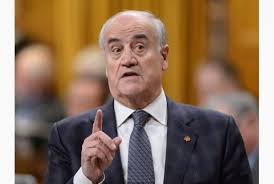 Julian Fantino served as a police chief in several major Ontario communities; went on to become the Commissioner of the Provincial Police and then got himself elected to the House of Commons and became a Cabinet Minister. It all looks good on a resume – but there wasn’t much done that should be remembered. So it is little wonder that Harper welcomed Fantino into Cabinet immediately after he won a 2010 by-election for the Tories. And Fantino dutifully served his master in a number of minor portfolios. That is until he was promoted to be the Minister of Veterans Affairs, a natural and deserved placement for such an experienced security professional.
But last week the PM had to fire his appointee and reassign him back to where he could do less harm. Although Fantino had a nasty habit of insulting his clients – our veterans – it took a scandal, where a billion dollars slipped through his hands while veterans were left in need, to get him removed.
Julian Fantino is symptomatic of what is wrong with Mr. Harper’s government and why the Tories are puttering in the polls, except in Alberta, of course. It’s not just the thuggish behaviour or the lack of compassion, which unfortunately characterizes this Conservative government. It’s about the government’s performance.
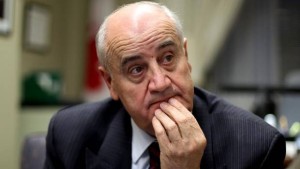 Now in a minor Cabinet role, Fantino will have to pull in the Italian vote in the province – can he even be re-elected? Today’s Conservative political platform is really just so yesterday. After nearly a decade with the same old gang in Ottawa, voters are looking for the ‘refresh’ button. Despite all that budget cutting and public service bleeding, voters are asking where the benefits are.
This upcoming election will be about fairness; about reducing the ever-increasing spread between the rich and the poor; and about the place of the middle class. It will be about building much needed infrastructure and restoring economic prosperity across all regions of Canada. And it will be about preparing to meet the demands on our society from an aging population.
Julian Fantino fits that demographic but he still plans to run again in 2015. Should the voters give him another chance and the Tories win again, it is questionable whether he would be given a new Cabinet position. And if he didn’t get re-elected? Well he has had an outstanding career for someone who started out as a mall cop, and someone who had to volunteer before the police would even hire him.
Fantino should know, however, that he may not even get re-nominated. After all his boss has a nasty reputation for cutting his losses, and throwing those who screw up under the bus – just ask Duffy. So I’m guessing we’ll hear a swan song at an upcoming retirement party, sooner than later.
 Ray Rivers writes weekly on both federal and provincial politics, applying his more than 25 years as a federal bureaucrat to his thinking. Rivers was a candidate for provincial office in Burlington where he ran against Cam Jackson in 1995, the year Mike Harris and the Common Sense Revolution swept the province. Ray Rivers writes weekly on both federal and provincial politics, applying his more than 25 years as a federal bureaucrat to his thinking. Rivers was a candidate for provincial office in Burlington where he ran against Cam Jackson in 1995, the year Mike Harris and the Common Sense Revolution swept the province.
Background links:
Fantino
G20/8 Veterans Affairs Demoting Fantino Top Ontario Cop
G8 Secret Law G8 Civil Liberties More G8 Even More G8
Fantino in Cabinet Latest Polls Alberta Oil
Economy


By Gary Scobie
January 5, 2015
BURLINGTON, ON
A four part feature on the city’s decision to sell small parcels of land that it owns that fronts on to Lake Ontario between Market and St. Paul Street. Part 2: The Scobie delegation.
I come here today with some hope in my heart. We have a new Council in session, and though the names and faces remain the same, we on the Waterfront Committee are hoping that perhaps, in the spirit of renewal of your vows to do what is best for all citizens of Burlington, you rethink this issue of selling public waterfront owned by all of us to a few chosen citizens.
 Gary Scobie delegating on behalf of the Burlington Waterfront Committee to stop the sale of waterfront property owned by the city. We have a grand vision; it’s actually a hundred year vision, not unlike the vision of the Waterfront Trust and their Ontario Waterfront Trail. Their vision is to link the public to their waterfront and to establish a contiguous walking trail along the shores of the St. Lawrence and Lake Ontario first and next Lake Erie, followed by all the Great Lakes on our border. Theirs is certainly a long term vision.
Our vision in Burlington is to have a contiguous walking trail along our Lake Ontario and Burlington Bay shorelines. Each Window to the Lake is like a pearl; each trail between them is like a strand, so the end result would be like a strand of pearls along our shoreline. It could be magnificent.
This vision may seem unrealistic, yet big visions have been hatched and developed in our area before, with great success over time. My wife and I belong to the Bruce Trail Conservancy. The Conservancy is celebrating its 50th anniversary of inception in 2014. In 1964, a small group of dedicated visionaries imagined a natural walking path along the entire length of the Niagara Escarpment, from Queenston to Tobermory.
An “Optimum Route” was mapped out and volunteers began to work with local governments, landowners, conservation authorities and other naturalist groups to create this path on a protected from development basis. Their vision was certainly long term and audacious. Fifty years on, half of the 880 kilometer trail is secure in Conservancy hands or in the hands of government agencies.
The other 50% is either trail on private lands with landowner permission or routes on public roads where permission or ownership has not yet been attained. Will it take another 50 years to secure the whole trail? Perhaps, and maybe even longer, but the vision is still intact and progress toward the goal continues every single year.
This is what can happen when there is leadership and there is a grand vision. The same thing can happen over the next hundred years if we in Burlington dedicate ourselves to this mission.
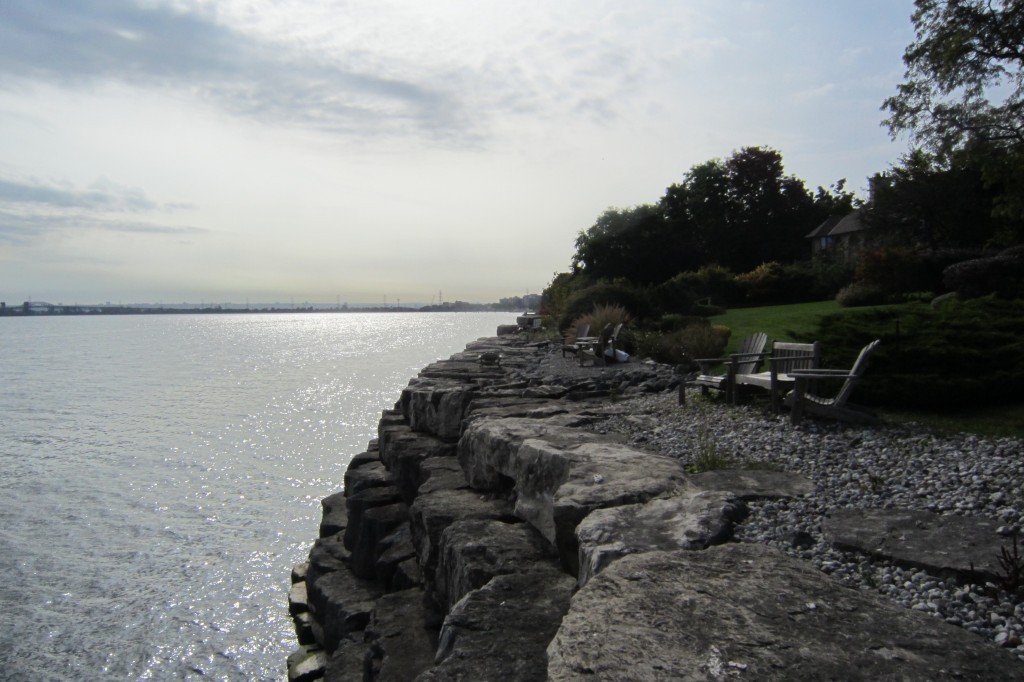 Gary Scobie thought this could become one of the strands in the string of waterfront pearls that would become a complete Burlington Waterfront Trail. We thought last year that we had a chance to put a strand in place between the Market and St. Paul Street Windows to the Lake. It didn’t even seem bold, since the land was already in public hands. A staff recommendation, with advice from the City’s Legal Department, recommended that the lands be retained for a future parkette and Waterfront Trail between the Windows.
This future trail would be similar, yet different to the Waterfront Trail at Sioux Lookout Park between Guelph Line and Walkers Line. It would have a good length, about two-thirds of that at Sioux Lookout, but would be quieter and more natural because it would be away from Lakeshore Road noise and activity, buffered by the houses between the trail and the main road. And instead of having two static “no exit” Windows at St. Paul and Market, the public would get a through trail whether coming from east or west.
An ideal place to walk or cycle through or take a break on a bench beside the trail and the shore while moving along the Waterfront Trail. Again, similar but different than the experience at Sioux Lookout.
But something unexpected happened. For reasons still not adequately explained to the public, the “old” Council discussed the issue in a closed session, then voted to sell the land, against staff and legal recommendations to retain it. Before our first strand had been completed, we saw a knife slice it and dash our hopes for the future.
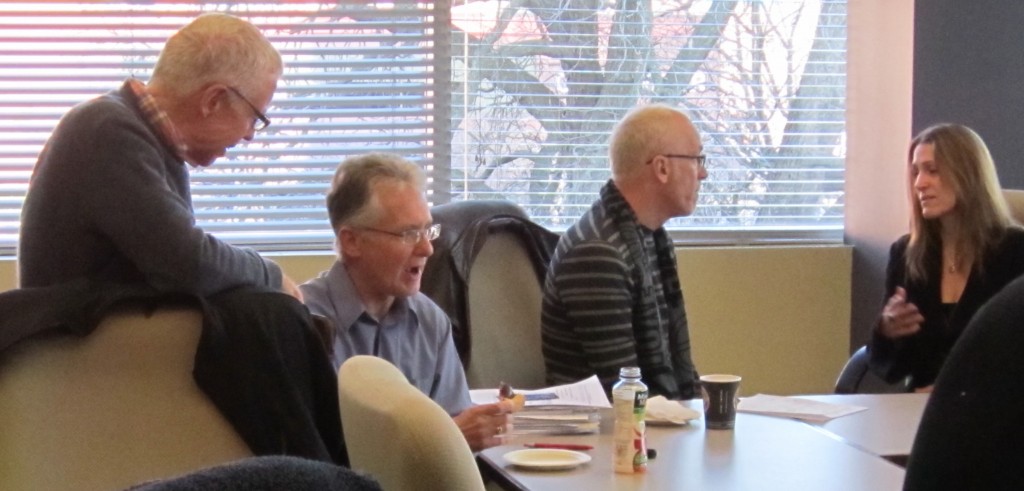 Gary Scobie, second from the left, was part of the city’s Waterfront Advisory Committee and went on to be part of the Burlington Waterfront Committee. Councillor Marianne Meed Ward is on the far right. Despite overwhelming numbers of delegates appearing here on October 13, 2013 to ask you to retain this shoreline land versus delegates asking to sell; despite overwhelming emails received urging retention versus sale, the “old” Council reversed the proportions and overwhelmingly voted 6 to 1 to sell the land, without any evidence given whatsoever that the broader public endorsed this view and the denial it imposed, possibly forever, of a public shoreline pathway there.
But a “new” Council may yet listen to our voices and the voices of neighboring residents and citizens who can see and share this vision of a start to the string of pearls that parkettes between Windows can be. We ask that you do not approve the sale of these lands to private interests and that you dedicate yourselves to preserving, not selling public waterfront. We ask that you look to ways to make use of other Water St. shore lands to form future strands. We ask that you look at ways that new development and re-development along our shores can create Waterfront Trail sections for the public. We ask that you consider what Burlington could be a long way down the road and that you buy into this long term vision, not put a dagger in its heart at its very inception.
Yesterday I received up updated advisory email from Marlaine Koehler, Executive Director of the Waterfront Regeneration Trust, amending her Jan 20, 2014 memo to Council. In it she states their position might not have been clear then, in light of newer information.
The Waterfront Regeneration Trust’s position today is:
1. Public lands on the Great Lakes waterfront should stay in the public realm and accommodate the Waterfront Trail. Burlington was one of the founders of the Trail.
2. If in fact, the land sale can be revisited, The Waterfront Regeneration Trust urges the City to do so, and retain ownership/interest in the lands so that they may eventually be incorporated into Burlington’s Great Lakes waterfront system.
So today you will decide to send a clear message that Burlington either supports the Waterfront Trail or that it doesn’t.
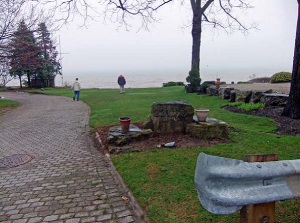 No city signage on this piece of city owned property. Plans are in place to make a proper Window on the Lake at this location. Burlington – Best Mid-Size City. Burlington – Family Friendly. Burlington – Urban and Rural. Burlington – Lake and Escarpment. In Burlington, we celebrate and boast of our waterfront. A decision now to sell means we will be adding a new moniker – Burlington – Public Waterfront For Sale.
Please stop these sales and approve your original staff recommendation to retain the land.
Gary Scobie has been around election issues for a long time. He was raised in Dundas, stayed there until graduating from McMaster, and considers Dundas his home town. He began working in Burlington in 1979 and has resided here since 1980. He has been involved in waterfront issues for the past six years and is a member of the Burlington Waterfront Committee.
Scobie was the lone delegator on the matter of the recommendation to stop up and close Water St. land parcels and sell the property to the three abutting property owners.
Links:
Part 1 How the decision to sell the waterfront property got made.

 By Staff By Staff
January 4, 2015
BURLINGTON, ON.
Ray Rivers will not be with us this week. He is in New Zealand pondering what he wants to do in 2015 and doing some R&R with his wife who is a New Zealander.
 Gazette columnist Ray Rivers checking out local media in New Zealand. Grandchildren, family dinners with copious amount of wine and good conversation will keep him busy until we see him back in Canada at the end of February.
He will write his column from New Zealand and will appear every second week.
Meanwhile he peruses the local media.

|
|
 By Pepper Parr
By Pepper Parr






























 An award given by a community with the nomination coming from people who have taken the time to think about who they want to recommend is a true award. When Mom fills in the form and sends it in – it just isn’t quite the same.
An award given by a community with the nomination coming from people who have taken the time to think about who they want to recommend is a true award. When Mom fills in the form and sends it in – it just isn’t quite the same.


 In fact, Germany has stated that it will not ratify the draft Canada-EU trade deal unless sections granting the rights of companies to sue governments are removed. Ms. Merkel understands the danger to her ability to govern her people in the face of a trade agreement which allows companies to ignore environmental and other regulations – or to sue the government.
In fact, Germany has stated that it will not ratify the draft Canada-EU trade deal unless sections granting the rights of companies to sue governments are removed. Ms. Merkel understands the danger to her ability to govern her people in the face of a trade agreement which allows companies to ignore environmental and other regulations – or to sue the government. Ray Rivers writes weekly on both federal and provincial politics, applying his more than 25 years as a federal bureaucrat to his thinking. Rivers was a candidate for provincial office in Burlington where he ran as a Liberal against Cam Jackson in 1995, the year Mike Harris and the Common Sense Revolution swept the province.
Ray Rivers writes weekly on both federal and provincial politics, applying his more than 25 years as a federal bureaucrat to his thinking. Rivers was a candidate for provincial office in Burlington where he ran as a Liberal against Cam Jackson in 1995, the year Mike Harris and the Common Sense Revolution swept the province. 





 His first Cabinet role was as a pit bull in the Harris government, oppressing the poorest and most vulnerable Ontario residents during the mid 1990’s recession. As Minister of Community and Social Services, he was the ruthless Tzar of Harris’ reactionary WorkFair program.
His first Cabinet role was as a pit bull in the Harris government, oppressing the poorest and most vulnerable Ontario residents during the mid 1990’s recession. As Minister of Community and Social Services, he was the ruthless Tzar of Harris’ reactionary WorkFair program.


 Ray Rivers writes weekly on both federal and provincial politics, applying his more than 25 years as a federal bureaucrat to his thinking. Rivers was a candidate for provincial office in Burlington where he ran against Cam Jackson in 1995, the year Mike Harris and the Common Sense Revolution swept the province.
Ray Rivers writes weekly on both federal and provincial politics, applying his more than 25 years as a federal bureaucrat to his thinking. Rivers was a candidate for provincial office in Burlington where he ran against Cam Jackson in 1995, the year Mike Harris and the Common Sense Revolution swept the province.










 Henrietta, after recovering from small pox, continued to live at Rock Bay. When she became too elderly to live there on her own, she went to live in Hamilton.
Henrietta, after recovering from small pox, continued to live at Rock Bay. When she became too elderly to live there on her own, she went to live in Hamilton.







































